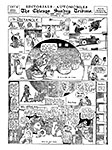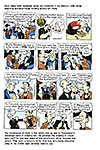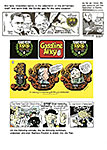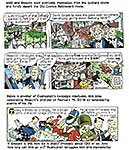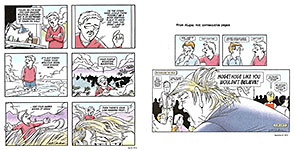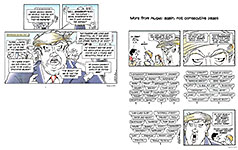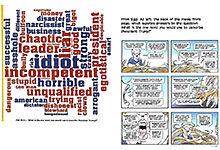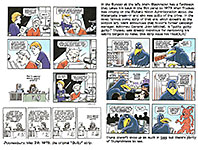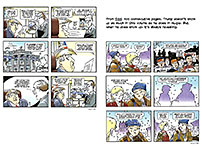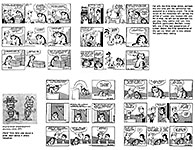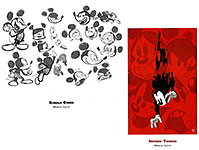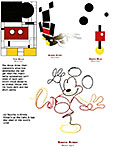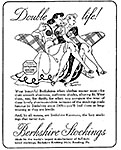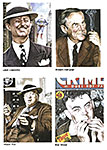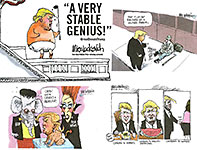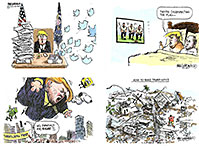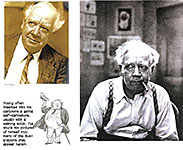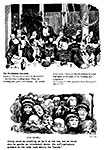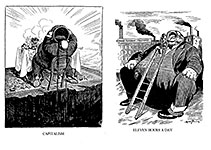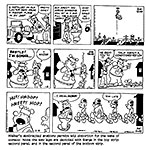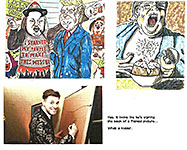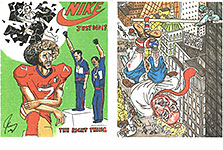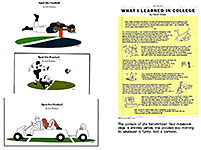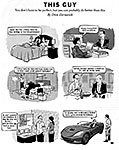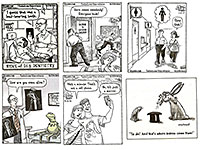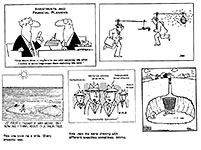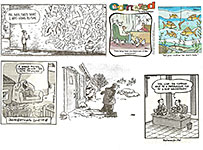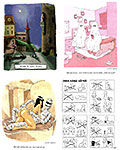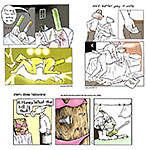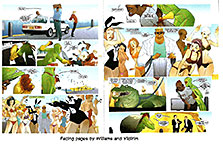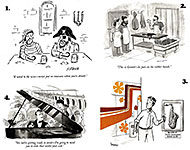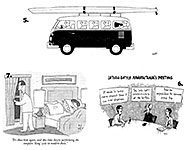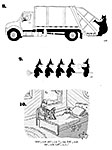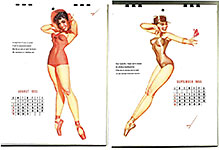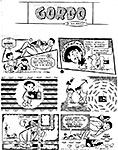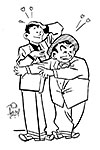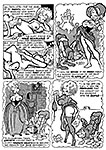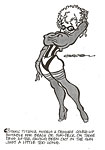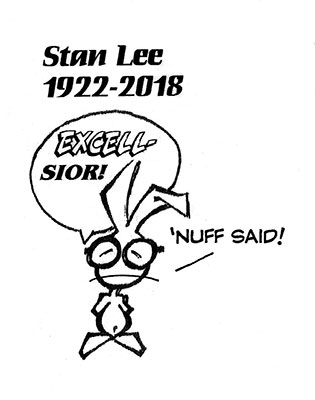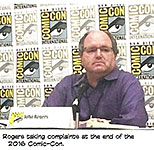 |
||||||||||||||||||||||||||||||||||||||||||||
Opus 387 (December 14, 2018). For our Anyule Edition, we have jammed a Christmas Stocking full of goodies. This time, we’re into book reviews of all dimensions and editoons galore, both departments that we slighted in our last epic posting, Opus 385, in order to devote time and space to news and funnybook reviews. Just to even matters out, we’re slighting those two categories this time. This time, in addition to two-months’ worth of editorial cartoons and 14 book reviews, we celebrate Gasoline Alley’s 100th anniversary and Mickey Mouse’s 90th, and we parade some of Harv’s hand-crafted calendar girls in front of you. And to enable you to choose the articles you want to peruse, here we’ve listed what’s here, in order, by department—:
NOUS R US Funnybook Recalled—A First? Superheroes at the Smithsonian Popeye Gets Younger Knight Life on TV Where’s Superman?
TRUMPERIES Quirks and Antics of the Raging Trumpet Ego
EDITOONERY A Culling of the Current Crop of Editorial Cartoons Plus Interludes on—: Thoughts Inspired by Kavanaugh Hearing How To Reform Male Sexual Conduct Getting Fired for Taking an Unpopular Position The Time George H.W. Bush Stuck It to Dan Rather
ACCRETION OF INTENTION DEPARTMENT The Bungle Family Tarzan of the Apes More IDW Library of Comics Essentials— Dan Dunn: Secret Operative 48 The Visual Comedic Delights of Baron Bean
NEWSPAPER COMICS PAGE VIGIL Thanksgiving in the Funnies Gasoline Alley’s 100th Anniversary Celebration
BOOK MARQUEE #Sad!: Doonesbury in the Time of Trump Garfield: Complete Works, Vol.1: 1978-79 The Art of Walt Disney’s Mickey Mouse More Heroes of the Comics by Drew Friedman “A Very Stable Genius” More Mycroft Casey Ruggles Lance
INTERVIEWING TRUDEAU BOOK REVIEW Laugh That We May Not Weep: The Life and Times of Art Young Talking Mort Walker: A Life in Comics More Carrey Cartoons
A-GAGGING WE GO Critiquing—: Esquire Playboy New Yorker Plus an Independent Harvest of Some Good Ones
LONG FORM PAGINATED CARTOON STRIPS My Heroes Have Always Been Junkies
COLLECTORS’ CORNICHE My Calendar Girls
PASSIN’ THROUGH Stan Lee John Rogers of San Diego Comic-Con Poem: Hidden Promise
QUOTE OF THE MONTH If Not of A Lifetime “Goddamn it, you’ve got to be kind.”—Kurt Vonnegut
Our Motto: It takes all kinds. Live and let live. Wear glasses if you need ’em. But it’s hard to live by this axiom in the Age of Tea Baggers, so we’ve added another motto:. Seven days without comics makes one weak. (You can’t have too many mottos.)
And our customary reminder: don’t forget to activate the “Bathroom Button” by clicking on the “print friendly version” so you can print off a copy of just this installment for reading later, at your leisure while enthroned. Without further adieu, then, here we go—:
NOUS R US Some of All the News That Gives Us Fits
FUNNYBOOK RECALLED Here’s a first. Well, for this week anyhow. Image Comics has issued a Mandatory Product Recall for a comic book. Turns out there’s a bar in New York that has registered its name, Dead Rabbit, and the character who appears in the comic books they use as menus and promotional items. So Image had little choice: to avoid a trademark fight, it recalled the first two issues of its comic book by that name. “You know what happens as a result of course,” says Rich Johnston at bleedingcool.com. “No one returns any copies, mandatory or not. And all the retailers just put them on eBay. Sixty-three copies of Dead Rabbit have just sold on eBay in the last couple of hours, since the message went out to retailers. Copies are being listed for $20-$50.” Johnston goes on to report that “the name Dead Rabbit comes from an Irish street gang in the Five Points. An infamous proto-supervillain, the Catwoman-like Hell-Cat Maggie, was an early member Dead Rabbit in the 1840s.”
SUPERHEROES MAKE IT TO THE SMITHSONIAN The Smithsonian museum has mounted a small, “but choice,” exhibit made up of some extremely surprising pieces, Mike Rhode reports at comicsdc.blogspot.com. “The terse description on their website only hints at it: “This showcase presents artifacts from the museum's collections that relate to Superheroes, including comic books, original comic art, movie and television costumes and props, and memorabilia. The display includes George Reeves's Superman costume from the ‘Adventures of Superman’ tv program, which ran from 1951-1958, as well as Halle Berry's Storm costume from the 2014 film ‘X-Men: Days of Future Past.’” Rhode goes on with a more detailed description: Of the five exhibit cases, two concentrate on comic books and original art, while the other three contain props from movies and pop culture ephemera. Surprisingly, the Black Panther costume from the Marvel movies which the museum collected this summer is not included, but as noted above they have displayed George Reeve's Superman costume (since it is in color rather than grey shades, it came from the later seasons of the television show), Halle Berry's Storm uniform, along with Captain America's shield, Wolverine's claws and Batman's cowl and a batarang. Those three cases are rounded out with the first issue of Ms. Magazine which had a Wonder Woman cover, two lunchboxes (Wonder Woman and Marvel heroes), and a Superman telephone. The show opened November 20 and will remain open until it closes September 2, 2019.
POPEYE GETS YOUNGER Beginning in 2019, in a new series of animated shorts, created to celebrate Popeye’s 90th birthday next year, the sailor-man will appear as “a more youthful, environmentally resourceful fellow, who lives in a washed-ashore houseboat, collects rainwater and grows his own spinach. “The animated series will also make other updates,” continues George Gene Gustines at nytimes.com. “A clean-shaven Bluto, for example, is interested in stealing Popeye’s spinach more than he is the heart of Olive Oyl, who has cast aside the role of damsel in distress [and become] a more independent woman.” The newspaper comic strips will also be different. They’ll be presented online as “Popeye’s Cartoon Club,” and they’ll be drawn by a different cartoonist each week. “The target audience also skews a little older.” Popeye first appeared on January 17, 1929 as a walk-on character in E.C. Segar’s Thimble Theatre. But he soon took over the strip. His world-wide popularity, however, was fosters by the animated cartoons, not the comic strip, which, subsequently, road to fame on the films’ successes.
KNIGHT LIFE ON TV A new television show based upon the life of cartoonist Keith Knight is being conjured up for a half-hour comedy, written by Knight himself and Marshall Todd, with Will Gluck and Eric Christian Olsen set to exec produce. Titled “Woke,” reports Lesley Goldberg at hollywoodreporter.com, “the single-camera comedy revolves around an African-American cartoonist who is on the cusp of mainstream success when his mild comics take a decidedly provocative tone following a run-in with police. Now, Keef (Morris) is in an irreversible state of ‘woke’ as he struggles to navigate his day-to-day existence — without blowing up everything he's built — while animated objects invade his reality.” The potential series will be a combination of live-action with animated sequences. Knight produces two autobiographical comic strips, both presumably source material for the tv show: The K Chronicles is somewhat off-beat and appears most often in alternate periodicals; The Knight Life is a syndicated comic strip published in mainstream newspapers. His work often explores racial and political topics. “Woke” appears on the horizon as animated fare continues to be among the most-streamed original and acquired content on outlets like Hulu and Netflix, according to Gloldberg. “Both companies are making major pushes in the space, with ‘Woke’ having both a timely live-action story and ability to woo the animation crowd as well.”
WHITHER SUPERMAN? I was a third of the way through the DC Previews 90-page catalog this month (it arrived just a couple days ago) before I realized I hadn’t seen any comic book covers with Superman on them. The publishing company that Superman founded and he’s not in conspicuous view? Out of 60 titles listed, only two are Superman titles—Action Comics and Superman. Supergirl shows up. But that doesn’t count. The flagship character used to be Superman. No longer. It’s all Batman now.
Fascinating Footnit. Much of the news retailed in the foregoing segment is culled from articles indexed at https://www.facebook.com/comicsresearchbibliography/, and eventually compiled into the Comics Research Bibliography, by Michael Rhode, which covers comic books, comic strips, animation, caricature, cartoons, bandes dessinees and related topics. It also provides links to numerous other sites that delve deeply into cartooning topics. For even more comics news, consult these four other sites: Mark Evanier’s povonline.com, Alan Gardner’s DailyCartoonist.com, Tom Spurgeon’s comicsreporter.com, and Michael Cavna at voices.washingtonpost.com./comic-riffs . For delving into the history of our beloved medium, you can’t go wrong by visiting Allan Holtz’s strippersguide.blogspot.com, where Allan regularly posts rare findings from his forays into the vast reaches of newspaper microfilm files hither and yon.
Further Ado In life, we can’t go long so we should go wide and deep.
TRUMPERIES Quirks and Antics of the Raging Trumpet Ego WE
DUMP INTO this Department all the hyper-trivial large and small manifestations
of the Trumpet Ego Rampant so we can devote the ensuing Editoonery Department
to serious political commentary. And to get us started, here are photos of a
couple statuettes by Kimber Fiebiger of Minneapolis that deliberately belittle
the aforementioned Ego. In the second, the poem on the base of the monument to Trumpery reads: “Trumpty Dumpty built his wall / Trumpty Dumpty’s regime did fall / Despite his cronies and all of his kin. / Now American will be great again.” What fun. Trumpty Dumpty indeed. At
the top of our next visual aid is a scan of a painting the Trumpet has recently
installed in the White House. A friend of the artist gave Trump a large print of the painting, and Trump pronounced himself pleased—so pleased that he had the print framed and hung in the White House near the Oval Office. Upon receiving the print, Trump phoned the artist, Andy Thomas, to express his delight. “One thing he specifically mentioned,” said Thomas, interviewed by Julia Jacobs at nytimes.com, “was that he didn’t usually like portraits of himself. But he said he really likes this one.” Perhaps he likes it because he appears so youthful in it with lean physique and flashy smile. Thomas admits that he shows Trump as slimmer than he is in real life. “I do that with everyone, even self portraits,” he said, “—it’s a feelgood painting, and I make them as good-looking as I can.” That Trump would hang a print of the painting in the White House is entirely in character, Thomas told Jacobs—both from the point of view of the president’s ego and his willingness to honor a piece of kitsch created by an ordinary voter. I’d say more ego than anything else. In the bar at his Mar-a-Lago, Trump hung a portrait of himself as a much younger man in sporting whites entitled “The Visionary.” Thomas probably agrees with me (or vice versa). The picture is “really Donald Trump all over,” he said. “It’s populist, and he’s not going to be shy that he’s the center of attention. I like that. Be yourself.” Thomas also pointed out that he nodded to feminism—a blurred image of a woman approaching the table out of the crowd. Thomas told Time that it represented a future female president, a confident figure who would not be intimidated approaching a table of powerful men. Thomas has painted similar pictures of Republicon presidents and Democrat presidents, sitting around a table playing poker or at the edge of a swimming pool.
AT THE BOTTOM if the exhibit at hand is my own drawing of Trump, my favorite so fat. It's just a quick sketch, but I'm delighted with it. It depicts Trump as I have seen him in my so-called mind’s eye since he first announced his candidacy for Prez. He's the guy on the barstool at the end of the bar during Happy Hour. He's sitting there, drinking steadily and slowly getting drunk, and in the meantime, sounding off on everything that occurs to him and always in the most authoritative manner— because he's right and no one else is. Barstool Trump. Monarch of All He Surveys. Forever. I doubt that I’ll ever turn the sketch into a finished drawing. I like the sketchiness, and I could never re-capture that free and loose manner in a finish.
OUR
NEXT TRUMPERY is an attempt to depict the vaulting ego of the Trumpet—a futile
attempt, I’d say, but all attempts at capturing the monumental size of the
Trumpet ego are futile—this one showing him as a much decorated Emperor in
Chief concocted by Siegfried Woldhek for The New York Review of Books. Next, Bill Bramhall was doubtless inspired by the White House staff’s presumed response to Bob Woodward’s book, Fear, which relies extensively upon confidential revelations about the Trumpet’s behavior. Who, His Imperial-ness must be asking—who squealed? For a related and comically revealing touch, Bramhall has the Emperor wearing the “new clothes” of the aged anecdote, which implies that the indiscretion everyone is denying having committed is simply asserting that the Emperor is not wearing a new and brilliantly designed garment but is, in fact, buck naked. Bravo. Matt Wuerker offers a fresh vision of the Trumpet’s administration. The White House has been vandalized, obscenities scrawled on its walls, and the Prez himself is a horned demon. But the GOPachyderm doesn’t see any “collusion” so there’s no need to interfere. This is partisan myopia on a grand scale—exactly the behavior of the current Congress. (“Congress,” by the way—although not at all incidentally—has an antiquated meaning, “sexual intercourse,” so every time you hear the word “congress” think of it as that institution’s way of saying “fuck you” to all us voters.) The
Trumpet has lately revealed that his intellectual brilliance is in his gut, and
in the upper left corner of our next display, Jim Morin’s image shows us
why: it’s money that drives Trump’s decisions (more so recently when the Prez
declined to pursue the Crown Prince of Saudi Arabia as the instigator of the
murder of Jamal Khashoggi). The size of the gut, of course is determined by the
amount of money involved. Next around the clock, Chris Britt shows us how the Trumpet can deny climate change. Ignorance abetted by stupidity. Willful blindness. His habitual posture. When a climate report was issued earlier this month by 13 federal agencies, reporting, after two-and-a-half years of study, dire consequences if nothing is done to curb a man-made warming trend, the Trumpet simply dismissed it. “I don’t believe it,” he said. Later he added that “people like myself” with “very high levels of intelligence” don’t accept the scientific consensus that human activity is responsible for climate change. His gut had very high levels of intelligence. And this is the leader of the Free World. Britt, Clay Jones’ visual recalls an actual incident of Trump boarding Air
Force One with toilet paper clinging to his heel. Jones makes the tp into a
certain pesky political activism. And Adam Zyglis invokes Woodward’s
book, Kicking off our last demonstration of Trumpet tomfoolery is David Fitzsimmons with a succession of images that reveal what life in the Trumpet’s White House is like—a series of temper tantrums. Then Ward Sutton resorts to comic strip format to present a series of events showing how Russia’s Putin controls the Trumpet—er, the Republicon Party. And fnally, here’s Pat Bagley to demonstrate how Rudy Giuliani is advising the Trumpet (with one of te most memorable caricatures of Rudy around). And that’s enough Trumpery for the nonce. Onward to Serious Editorial Commentary.
Letter-to-editor—: I admit to being biased against the opinions expressed in Mallard Fillmore. However, the October 2 release, which reads “Senate Democrats now claim to have anonymous reports that Brett Kavanaugh ran in the halls multiple times in second grade,” is disrespectful and insensitive regarding the issues of sexual harassment and assault which have been raised in the Senate hearings.
EDITOONERY The Mock in Democracy THE LAST TIME we examined the current crop of editorial cartoons was in September’s opus, and some occasional happenings have happened since then. The major newsstories of the last two-and-a-half months are the Kavanaugh hearings, the murder of Saudi journalist Jamal Khashoggi, the “invasion” of a caravan of Central Amerian migrants, and the mid-term election. We’ll take them up in that order with the help of the usual gang of inky-fingered crusaders.
THE
CONFIRMATION HEARING of Brett Kavanaugh’s candidacy for a seat on the Supreme
Court was doubtless the noisiest of the notable events. In our first visual
aid, Matt Davies shows us that Kavanaugh’s fate was all but determined
in advance by the combination of facts surrounding his nomination: And then, next around the clock, John Darkow offers a vivid image of what happened next: Kavanaugh’s uninterrupted progress towards the Supreme Court was interrupted by #MeToo in the form of an accusation from a psychology professory, Christine Blasey Ford, who contended that Kavanaugh had groped her at a drunken party while they were both in high school. The groping she interpreted as attempted rape. And the experience has haunted her for all of the 36 years since. But once again, as Clay Jones demonstrates, Ford’s prospects before the Senate Judiciary Committee seem as likely of success as Anita Hill’s in the 1991 hearing on Clarence Thomas’ candidacy. The Committee’s membership is still all male, mostly old white guys, who have historically been reluctant to take a woman’s word about assault. In 2018, however, the Grandstanding Obstructionist Pachyderm, recognizing that it could be accused of sexist biases, brought in a female law professor to quiz Ford, and David Fitzsimmons captures the moment by depicting the small-minded committee members as tiny irritable old men, hiding behind a woman. After
Ford’s testimony, a remarkably restrained, emotionless recitation of the facts
as she experienced/perceived them, Kavanaugh was given a chance to refute the
charges. Which he did in an emotional outburst combining livid anger and the
shedding of tears. In two panels at the upper left of our next exhibit, Matt
Davies contrasts the two witnesses, enlisting the antagonistic axiom “he
said/she said” to make his point memorable. At about this time in this suspenseful unraveling, we began to hear various segments of the population calling for the FBI to investigate Ford’s story and Kavanaugh’s. Since Kavanaugh had already passed a background check, the GOP majority was inclined to ignore such demands. And then Senator Jeff Flake stepped up. Flake is fearless because he has decided not to run for re-election. A member of the Judiciary Committee, Flake said he would vote to advance Kavanaugh’s candidacy for a vote by the full Senate, but he would not vote for Kavanaugh in that show-down unless the FBI were given a week to investigate. Given the narrow margin of the Republicon majority in the Senate, Flake’s opposition on the floor would doom Kavanaugh’s candidacy. The committee voted to let the FBI investigate. On “60 Minutes” September 30, Flake was interviewed. He was asked if he could have conducted this now-famous stalling maneuver if he were running for re-election. He laughed and said “No chance!” It could never have happened if he were running to be re-elected. And that’s the state of American democracy these days: an elected leader cannot voice his conscience and expect to be re-elected, so no one is speaking from the heart or mind of conviction. They all engage in party-speak, hoping party loyalty will get them re-elected. And getting re-elected is the be-all and end-all of political life. Sad.
THE INVESTIGATION PROVED TO BE A FARCE, as Mike Luckovich demonstrates with an image of Sherlock Holmes and Watson whose work is governed entirely by a stop watch: the Trumpet gave the FBI only a week to conduct it’s investigation and restricted the areas it could explore. Clay Bennett gives us a memorable visual metaphor for the results of that investigation: it’s full of holes. In
the upper left of the next display, Khalil Bendib deploys a famous
image— Michelangelo’s picture on the ceiling of the Sistine Chapel that shows
God bringing Adam to life with a touch of fingers— as a visual metaphor to
depict the Supreme Court that the Trumpet has created in his own image. The
Trumpet’s image with his pants down is echoed in Kavanaugh’s image, both
stemming from their reputations in the way they treated women. Bendib, by the way (although not at all incidentally), grew up in North Africa (in what he no longer calls “Algiers”) but came to this country at the age of 20, received a master’s degree from the University of Southern California in 1982, and now, after resigning a position he held as a political cartoonist for the Gannett newspapers, freelances his work on the Web. His first two decades abroad give him a different (not to say jaded) perspective on American affairs. In 2008, according to St. Wikipedia, he famously conducted a spoof campaign for the U.S. Presidency—“A Fez for Prez”— claiming to be the first Muslim-American candidate (although Randall A. Venson, an actual candidate, preceded him in 2000.) Bendib’s signature dingbat is the bird you see at the lower right in the cartoon at hand. “It’s an ibis,” he told me, “—a North Africa bird, like me.” Bendib has published three collections of this cartoons, the first, in 2003, entitled It Became Necessary To Destroy the Planet in Order to Save It; in 2007, Mission Accomplished: Wicked Cartoons by America’s Most Wanted Political Cartoonist; and, most recently, Too Big to Fail, which can be ordered through his webiste, bendib.com. To purchase the others, consult AdAll.com. For even more about Bendib, visit Opus 228. Next around the clock of our exhibit, Tom Toles characterizes Kavanaugh’s future as a so-called independent Supreme Court justice. In his refutation of Ford’s accusation, Kavanaugh had heatedly alleged that the whole Ford episode was a plot engineered by wild-eyed liberals to destroy his candidacy, thereby revealing a hostility to liberal thought if not an unflagging support for conservatism, both unbecoming in a supposedly impartial Supreme Court justice. Toles deploys an image that relies upon a cliched trope to reveal the Pachyderm under Kavanaugh’s robe—i.e., his prejudice in favor of conservative Republicon positions. R.J. Matson turns our attention in another direction. The Senate’s GOP majority assures the confirmation of any Trump-nominated candidate for the federal bench. Using the success of Neil Gorsuch, Trump’s first SCOTUS nominee, and Kavanaugh as examples, Matson offers a image of the Senate edifice destroyed entirely by the purely political success of conservative candidates. Toles continues in the same direction by showing Justice, prone and defeated after an assault by the political majority. Others have questioned the legitimacy of the process. A majority in the Senate is about as undemocratic (small d) as is possible in the American system: every state gets two senators, regardless of the population of the state; so North Dakota, with a population of 785,952, has as many senators—and as many votes, therefore as much power—as New York, which is vastly greater in the number of its citizens, 19.38 million. Wherefor equality? What, then, of Kavanaugh, the newest Supreme Court Justice? Going in to the hearings, we knew that Kavanaugh was a dedicated conservative—a right-wing right-winger. He wouldn’t be on the Federalist Society / Heritage Fund lists otherwise. Coming out of the hearings, we knew two things that we hadn’t know before. First, we know Kavanaugh will lie—or bend the truth somewhat—when it suits him. Second, we know that his experience at the hearings undoubtedly soured him on liberals. He may have been sour before. But if not, he surely is now. And the question then is: can a man bitterly opposed to liberals render fair and impartial verdicts on issues affecting the left? Or the right, for that matter. Other
tangential issues are taken up in our next visual aid. We’ll take up this problem in more detail down the scroll. For now, we’ll plunge ahead to Nate Beeler’s two-panel cartoon that enacts exactly the injustice that I’ve just been talking about. My own cartoon, next around the clock, is (I trust) a memorable demonstration of the overall problem—the failure of too many males to keep their sexual yearnings under better control. Like Kavanaugh when he was a teenager. Like many males when teenagers, their peckers simply are too demanding to control.
WITH
OUR NEXT EXHIBIT, we return to another of the specifics of the Kavanaugh case,
namely the effort to silence Ford by denying her the opportunity to testify
before the Senate committee, an effort that ultimately failed. Next, Bruce MacKinnon conjures up another image—that of Lady Justice being held down as if she were being raped and silenced at the same time—exactly the image that Ford’s testimony creates of Kavanaugh’s treatment of her; the rapist’s cufflinks identify him as the Senate GOP. MacKinnon’s image recalls the most controversial editoon in South Africa’s history, the one created by Jonathan Shapiro aka Zapiro to show how President Jacob Zuma treated the justice system. I’m posting the cartoon here, but for a full explanation of its significance, return to Opus 263 and scroll down to “Zapiro: A Thorn in the Side.” The New Yorker also deployed a cover image of a woman being silenced. In the stark black-and-white imagery by Spanish artist Ana Juan, the smothering hand is blood red. “Ford speaks for the women who have no voice,” Juan said. Another
woman cartoonist launches our next display with a circus metaphor. Guerra is an accomplished Vancouver-based artist, noted until last February for being co-creator and lead penciller of the award-winning comic book Y: The Last Man. Following the 2016 election, she started doing editorial cartoons. And last February, she gained national notoriety for her cartoon about the heroism of a football coach who lost his life throwing himself in front of a bunch of students to protect them during the Valentine’s Day mass murder at a Parkland, Florida high school; see Opus 376 for details and a scan of the cartoon. Guerra’s
considerable skill at portraiture is on display in a recent collection of her
cartoons, Me the People (112 9x6-inch And she does a better-than-average job in rendering the Trumpet’s wife Melania in the first cartoon of our next exhibit, wherein she makes political rallies the thing that arouses her husband. But Guerra’s just having fun with this one—which nonetheless supplies an insight into Trump’s recurring desire for a seemingly unending series of “daddy needs love” rallies.
WE SHIFT TOPICS for the next cartoons. Mike Luckovich conjures an image that shows the GOP making suppressing women the basis of its new revised party symbol. Jen Sorensen offers a comic strip that makes women’s struggle against sexual harassment akin to a military battle. The comic strip form permits her to withhold until the last panel the insightful key that reveals that this faux military briefing is about the fight against sexual harassment. Joe Heller also deploys the comic strip format in his cartoon, which uses the form just as Sorensen did: in the last panel, Heller reveals that men, feeling threatened by sexual accusations, are now in a position much like women who are threatened by sexual harassment and abuse. Harassment
continues as our topic in the next visual aid. And back at the left, Clay Jones finishes this exhibit with one of his loopy caricatures of the Trumpet, who is depicted as so proud of his pecker that he uses images of it in his conduct of foreign policy. Diplomacy for Trump consists largely of how he and another world leader relate to each other personally—and for Trump, that means staying tough, being the macho man with a good penis. So naturally, he wants to advertise his dick. Next,
we see Mike Lester who deploys two panels to reveal the hazard of crowd
activism. Crowds are, after all, mobs and are therefore just a step away from
mob rule. Establishing tariffs, by the way, is Constitutionally the business of Congress not the President. Section 8.1 of Article 1 discusses the Powers Granted to Congress, which “shall have the Power To lay and collect Taxes, Duties, Imposts and Excises”—“Duties” being another word for tariffs. But Congress, ever supine in the performances of its obligations, gave up this power decades ago because its members didn’t want to do anything that might be unpopular enough to cost them the next election. And the Prez, recognizing that setting tariffs gave him power, assumed the job. Bob Gorrell’s opinion of the looming tariff war with China shows the Trumpet engaged in the ancient finger-trap game with China’s President-for-Life Xi Jinping. Both players are trapped: as long as each persists, neither can escape. Hence, the trap. But since the game originated in China, my guess is that Xi may be more adept at it than The Donald. At the lower left, Chan Lowe’s two-panel cartoon reveals two results of the tariff war: first, the cost of Chinese-made goods increases; second, the American consumer gets fed up with the higher prices. Lowe makes sarcastic use of a favorite Trump expression: he promised during his campaign that we would all get tired of winning. Right.
INTERLUDE THE FIRST Recognizing, as we do, that the Editoonery Department has swollen over the last couple months to a dimension not easily consumed without a break, we herewith take a break—in the form of an interlude of— Thoughts Inspired by the Kavanaugh Hearing Without attempting at all to formulate an over-arching philosophy that would embrace the various aspects of the Kavanaugh case, six thoughts occurred to me as I watched the whole travesty unfold. First, Kavanaugh probably did assault Christine Blasey Ford, just as she said he did. But he probably doesn’t remember doing it as Katie Herzog says in TheStranger.com: naturally, a traumatic event like the one Ford described would stick with her for life. But “in the toxic ‘bro’ culture of an elite prep school like the one Kavanaugh and his buddy Mark Judge attended, the guys likely viewed their actions of pinning a younger girl to a bed and clumsily feeling her up as a bit of drunken fun that didn’t lead anywhere. “When Kavanaugh says the assault never took place, that’s because for him, it did not. For her, it was a lifelong trauma; for him, it was ‘less than nothing.’” Just another one of those things that happen during his weekends of heroic boozing. Second—have we really moved into a cultural corner where adults are going to be held responsible for stupid things they did as teenagers? Until this episode captured the headlines, in our legal system, teenagers, who have not perforce attained the age of majority, are usually treated differently than adults who may have committed the same crime. Why? Because we (and our legal system) know that teenagers are not fully formed persons yet. They’re immature. They’re still, er, feeling their way. (Sorry.) Teenagers are often tried as adults when they commit serious crimes—murder, say. But when their offense is groping a teenager of the opposite sex—it’s a bad date but it’s not a crime. Yet. Third, Kavanaugh’s anger during his testimony after Ford’s revelation was, I think, genuine. His reaction was human, from the heart. He was insulted and reacted angrily—for himself and his family. If he didn’t remember groping her at a drunken party several decades ago, then the way he was being treated was certainly extreme and highly suspicious. But his anger—doubtless encouraged by the White House as a way of refuting Ford’s testimony—still looked remarkably like whining by a prep-school teenager, a pampered member of the elite who thought his eliteness called for better treatment. Fourth, has anyone notice that we’ve moved dramatically beyond the territory staked out by #MeToo? The Kavanaugh-Ford encounter did not occur in the workplace. Their encounter occurred in the realm of ordinary dating, albeit with repulsive behavior on his part. It’s the extreme bad date. Young men grope their dates. And sometimes young women participate by acquiescing, depending upon how curious they are or how much affection they bear for their date. This is the way of the world. Is the #MeToo movement going to be policing all relationships between men and women? Fifth, what has the #MeToo movement done to due process? We have mob rule instead. First, character assassination by a single accuser. Then, prompted by one revelation, other accusers come forward, forming a lynch mob, which, by its numbers alone, declare the guilt of the accused. Innocent until proven guilty? Not so much. It’s a system that is wide open for corruption. A lone woman can use the system to take revenge upon a man she dislikes or desires to take revenge upon. Her accusation is enough to destroy his livelihood. Yes, I know that’s a thread-bare contention. But it’s still a possibility. Yes, women deserve to be treated as a-sexual human beings, at least in the workplace. Their ability not their gender should determine their treatment. Good manners—which, alas, we lost track of long ago in this self-indulgent age—ought to prevail. Good manners and a measure of self-restraint. Finally, sixth, there oughta be a time limit on bad sexual behavior, like the legalistic statute of limitations. If the groping took place 25 years ago and you’re over 40, then the statue of limitations has run out. You can’t be indicted or fired or forever disgraced or sent off to live in a cave—unless you’ve persisted in the brutish behavior into more recent times. I’m sure about the math, but the idea of a statute of limitations seems useful. Does any of this mean either that I denigrate #MeToo or wish it would go away? No. In fact, I’m glad women are at last protesting the sexist treatment they’ve had to endure silently for ages. Probably no better way exists for them to bring this matter urgently to the attention of the societies they live (and suffer) in. #MeToo is a start but a bad end. It’s too easy to attack a man whom you simply don’t like and destroy him. Having aired the issue, we now need a better way of going forward—of insuring better, equal, treatment for women—and men— by means other than mob rule that destroys due process. And there must be a way. We’re an ingenious people. We can find a better way.
LECHERY AND THE PENILE PROMPT “God gave men both a penis and a brain, but unfortunately not enough blood supply to run both at the same time.” —Robin Williams HOW TO BEGIN REFORM of our sexual conduct. Start with something small and work up. Start by telling your son that when he is talking with a girl or woman he should look always only into her eyes. Don’t look anywhere else. You can look elsewhere when she’s not looking, but when speaking directly to her, always look into her eyes and nowhere else. Not a glance, however brief, at her cleavage or knees. Or any other part of her anatomy. The eyes, of course, are windows to the soul. But that’s not why I recommend this behavior (it is, however, an incidental benefit). I recommend looking only into her eyes because that’s where she lives, and she’ll appreciate your attending to her life rather than her looks. And then, having instructed your son, practice what you preach.
End of Interlude the First RESUME EDITOONERY THE MURDER of a renegade Saudi journalist named Jamal Khashoggi consumed more news time than it deserves were it not for the shameful response of the Trumpet. As we mentioned in Opus 385, murdering journalists in the Mideast is the sport of kings and other autocrats. According to Reporters Without Borders, a total of 65 journalists (including professional journalists, citizen-journalists and media workers) were killed in 2017. Twenty-six of them were killed in the course of their work, the collateral victims of a deadly situation such as an air strike, an artillery bombardment, or a suicide bombing. The other 39 were murdered, deliberately targeted because their reporting threatened political, economic, or criminal interests. And many of them were killed in the Mideast. So why all the fuss over one journalist, Jamal Khashoggi? Perhaps because his tenuous association with the Washington Post gives American news media the opportunity to headline at least one of the deaths the profession seems plagued by for simply covering the news. We never hear about the others. And then, of course, there’s the probable connection with the Saudi strongman, crown price Mohammed bin Salman, and the dubious relationship between MBS and the Trumpet. And it is this connection that attracted the attention of editoonists over the last few weeks. Patrick
Chappette captures the general aura that hangs over the killing of
Khashoggi in the cartoon at the upper left. David Fitzsimmons shows MBS counseling the Trumpet about the proper way to treat the “enemy of the people” with an exemplary horrific beating going on in the background. But next around the clock, Pat Bagley suggests that the Trumpet may know more about how to treat journalists than MBS does. The cartoon is capable of two interpretations: either Trump knows more brutal ways to take care of journalists—or, creditably, objects to killing journalists in favor of some other punishment. Matt Wuerker points out the American hypocrisy: we bemoan the treatment of a lone journalist while supplying weapons and military aid to Saudi Arabia in its war on Yeman, which has turned into a slaughter of civilians. Despite the bite of this criticism, what first attracted my eye to this cartoon was Uncle Sam’s alarm at learning about the bone saw. That was precisely my reaction. Who takes a bone saw into their consulate without having a sinister motive? In
the next visual aid, Martyn Turner shows what has happened to the
investigation of Khashoggi’s murder: money has obscured the killer’s tracks. (The head of the CIA had a meeting with some senators on December 4, and the senators walked away convinced of MBS’ culpability. Senator Lindsey Graham said one would have to be “willfully blind” to deny that the Prince ordered Khashoggi’s killing. The Trumpet qualifies: he has proven himself willfully blind repeatedly.) And Bill Schorr makes the relationship between MBS and the Trumpet glaringly apparent, reversing one of the Trumpet’s favorite expressions about a shoot-out on Fifth Avenue to apply to Trump’s worship of MBS. Then Chris Britt shows us what Trump has done with the grisly bone saw. By ignoring the preponderance of the evidence, Trump has effectively dismembered the United States, separating it from dignity, respect, truth, and morality. Or, as Monte Wolverton has it in his visual metaphor: the light has gone out of the U.S.A. as the lighthouse guiding other countries to improving human rights. This just over the transom: Time magazine has selected its Person of the Year for 2018—the collective journalist, as denominated in the persons of Khashoggi and three others (two, Wa Lone and Kyaw Soe Oo who have been jailed in Myanmar for a year, and Philippine journalist Maria Resssa, who founded and operates a truth-telling online site in President Rodrigo Duterie’s island dictatorship), plus the staff of the Capital Gazette in Annapolis, Maryland, where five were shot to death last June. The choice represented an effort to emphasize the importance of reporters’ work in an increasingly hostile world. Runner-up as the person who, for good or ill, most influenced the news of the year, was the Trumpet, whose campaign against the news media as “enemy of the people” is thrown into gross relief and shame by the first place occupants.
THE “CARAVAN OF INVADERS” wending its way northward to the U.S.-Mexico border provided exactly the gist for what the Trumpet has always deployed effectively. FEAR.
Tom Toles at the lower left changes the subject and focuses on the army of soldiers Trump has sent to guard the border even though the Posse Comitatus Act prohibits American military from acting within the borders of the country. So what were they doing? They were participating in Trump’s publicity stunt to drive up Republicon voting at the midterms. On
our next display, Rob Rogers drums up another parade, “the only caravan
threatening America,” made up of white nationalists, the KKK, and other fascist
undesirables—all vocal supporters of the Trumpet. The U.S. Army, meanwhile, contemplates the refugee woman and her children in the sights of the tank’s canon. Bill Schorr makes this confrontation laughable by quoting the commander of the tank, who confesses to feeling “like a damn fool.” When the immigrants reached the U.S. border at Tijuana, they fell into an impossible situation: several thousand of them (6,000?) were being temporarily housed in the city’s sports arena, and when they realized that the U.S. was processing only about 60 asylum claims a day, about 500 of them stormed border to plead for more speed. They were met with tear gas, turned on them when a few disgruntled immigrants flung rocks at the border guards. The refugees turned back. The entire group of thousands has since been moved from Tijuana’s sports arena to a former concert venue ten miles south of the city. Tom Toles converts that unhappy event to an image of the Statue of Liberty, tearing up from tear gas as she realizes American values weren’t made available to immigrants. Yes, we must defend our borders, said the New York Daily News (quoted in The Week, December 7), but we must also defend “American principles.” Under U.S. and international law, people who make a credible claim that they face persecution and violence at home can apply for asylum. If Trump weren’t so busy promoting “fever dreams of an ongoing invasion” to stir up his base, he wouldn’t send troops to the border—he’s send hundreds of asylum officers and immigration judges to expedite the claims. But Trump wants his wall. To what effect? As some wag observed a long time ago, if we can build a 30-foot wall, someone can build a 30-foot ladder. Or—yet again—another wag points out that just to the left of the presumed wall across the southern border of California is an ocean. Just a short boat ride and a shorter swim away from the U.S. mainland. What Trumpty bullshit we’re being made to tolerate.
THE MIDTERM ELECTION was the fourth of the big newsstories that slipped by us during the hiatus of the last few weeks. The Trumpet rushed forward even before all the ballots had been counted to claim that the results were “very close to a complete victory” even though the GOP lost the House. It was a victory for Trump, though, because he campaigned only for Republicon senators up for re-election, and the GOP gained two seats, partly as a result of Trump’s holding DNL (“daddy needs love”) rallies in several closely contested states. Not content with this kind of victory alone, the Trumpet also ridiculed by name any Republicon who lost the election ostensibly (to hear Trump tell it) because they didn’t ask for his help (and they didn’t because they didn’t want to be associated with him). Pollsters
were never confident of the outcome. Some said the Democrats would win the
House; others, that they wouldn’t. And the at various times, Senate seemed up
for grabs. Next, R.J. Matson ignores the pending election to deploy the “red wave” as a visual metaphor, a “wave” of red ink, the $179 billion deficit that the Trump-controlled Congress approved last winter. Trump, still exploiting fear of election fraud, pronounced a laughable scenario for fraud. After voting, he alleged, voters go out to their cars and change clothes and put on different hats, and then return to the polling place to cast another ballot. From this ludicrously childish explication, we know that Trump hasn’t voted in years. Woodward claims he hasn’t voted in a Republicon primary since 1988, but given his complete misunderstanding of the voter registration process (which is by name, not by clothing or any other appearance), it’s likely that Trump has never voted except for the primary in 1988. And it presents Clay Jones with an idea for a visual that is too good to pass up. And so he doesn’t. In the comic strip that ends this exhibit, Jen Sorensen provides a little drama at the polling place, showing a few of the ways that “interested parties” (i.e., Republicons) can suppress voting by people who might vote for the “other party.”
Interlude the Second GETTING FIRED FOR TAKING AN UNPOPULAR POSITION By Dino-Ray Ramos; msnbc After writing a 400-word Facebook post defending Brett Kavanaugh, who was accused of sexual assault by Dr. Christine Blasey Ford, news anchor Kris Long was suspended before resigning from his position at CBS affiliate KESQ-TV in Palm Springs.The post has since been deleted. The veteran journalist started off by supporting the #MeToo movement. “I have absolutely no sympathy for the increasingly long list of well-known names who have fallen from grace because they thought with their little head and not their big one.” Then, his thoughts start to take a turn. “You are beyond dreaming if you think 17-year-old boys are not going to misbehave from time to time as they begin to attempt relationships with the opposite sex,” he wrote. “That is just the way animals are made!” He also wrote “few things are more serious as rape” and that Ford’s accusation “stinks of political maneuvering.” Long added that if he were nominated Supreme Court, “they might have to enlarge the Senate hearing room to accommodate all the young women from the mid- to late-1960’s who felt that I had tried to go a bit too far!” Naturally, his comments and choice of words drew a lot of backlash from commenters and journalists before he deleted the post. Long replaced his deleted post with an apology, saying, “The previous post to this page has been deleted. This is a sensitive and controversial subject and I apologize for any offense that this has caused.” He released another statement on the day he resigned: “I want to thank those who have offered support and apologize again for any I may have offended. I hope to return to the news business in the future.” He added, “I wish I hadn’t written (the post) because it’s caused me a lot of headache. This is a sensitive and controversial subject and I apologize for any offense that this has caused.” But you are right.—RCH
Interlude Ends EDITOONERY RESUMES THE
FUNERAL for George H.W. Bush was today (December 5), and we watched some of it.
The chorus celebrating his humanity, kindness, international political acumen,
and sense of humor rang on through speaker after speaker. And I’m sure he was
all of those things. I was never a particular fan, but he seemed a wholly
decent sort and not without a trick or two up his sleeve. Editoonists were
nearly universal in their praise, several recalling his “thousand points of
light” speech and putting his image or name in “points of light” against a
star-studded sky. Bob Gorrell was one of several who asserted that Bush
was himself the one-thousand-and-first point of light. But some chose to remind us of Bush’s shortcomings—even Henry Payne, a staunch conservative, who plastered the back of Bush’s SUV with faux bumper stickers and other labels that revealed another dimension in Bush’s “kinder, gentler” political posture. Ted Rall, a wild-eyed liberal, piled up some of Bush’s failings in a comic strip format. And when we come to Jim Morin’s “power failure” at the lower left, we see some of the reason for the celebration of Bush as kinder and gentler: in contrast to the pompous self-promoting Trumpet, Bush is very nearly a saint as well as a masterful politician and military tactician. I remember an encounter beween Bush, as Vice President running for Prez, and CBS’s Dan Rather at which Bush came out as a canny interviewee. And Rather seemed an oaf by contrast. Here’s the story, quoted verbatim and in italics—:
The Time George H.W. Bush Stuck It to Dan Rather on Live Television By David Freddoso, Washington Examiner (with its presumed bias in favor of conservatives) PROBABLY MOST PEOPLE think of George H.W. Bush as the anti-Trump — genteel, reserved, and polite to a fault. And sometimes he was, but he also wasn't afraid to knife a journalist here or there when he felt it was deserved, or even just because it might distract from a potentially harmful story. [Freddoso then refers to a video in which] Bush famously stuck it to Dan Rather on the CBS news broadcast in the middle of a live interview in 1988. Bush was angry because Rather had led into this interview with a six-minute news piece that insinuated Bush was much more involved in Iran-Contra scandal than House and Senate investigations (controlled by Democrats, for what that's worth) had already concluded after extensive testimony and investigation. Bush came into the interview with an overtly combative mien, accusing Rather of misleading his audience. Rather reciprocated, repeatedly interrupting Bush's answers. Then, at about the six-and-a-half minute mark in the video, Bush dropped the bomb: "It's not fair to judge my whole career by a re-hash on Iran," Bush said. "How would you like it if I judge your career by those seven minutes when you walked off the set in New York? Would you like that?" Rather, who up to that point had done most of the talking, was flustered by this. Bush was referring to a 1987 incident in which Rather had caused CBS to broadcast several minutes of blank airtime. Angry that his news program was being truncated because of a women's tennis tournament, Rather got on the phone to argue with the network management and was absent from his post for several minutes when it was time to go live. The following night, Rather offered an editor's note on the interview, denying that he or CBS News had deceived Bush about what would be asked. Rather continued in journalism for another 17 years until he was finally drummed out. His final undoing was a too-good-to-check hit piece that his news team put together on Bush's son during the 2004 election. In both cases, Rather's involvement helped another Bush.
RCH resumes: You can find the video if you google George H.W. Bush Dan Rather and then click on the headline that I’ve repeated above. The encounter was exciting television if you like shouting matches. Bush emerged more credibly than Rather. Rather came gunning for Bush, determined to get Bush to admit to being involved in the illegal Iran Contra / arms-for-hostages deal—or to trap him into incriminating himself. Bush was too smart for that: after all, he was a life-long politician and knew his way around. And he came to the interview resolved to expose Rather as a biased reporter. Both were equally determined that he wasn’t going to let the other guy get away with it. Rather kept pushing. He didn’t want Bush to escape or to side-step his questions, all of which assumed that Bush was guilty. The honor of journalism was at stake! Pushing and pushing, Rather kept interrupting Bush, posing again and again aspects of the same question. And pretty soon, Bush started responding by talking over Rather, and then both were talking at the same time. None of us frustrated viewers learned anything from the interview—except that Rather was borish and Bush was trying as best he could to get the interview on a course of political discussion he’d thought he was going to have. We just sat there, listening to two people talking at once, neither making himself heard clearly by the viewers-listeners. Bush’s question, which shows he came to the interview prepared to unhorse Rather with a canny question reflecting on his journalistic integrity, didn’t really phase Rather as much as Freddoso claims it did. It stopped him for a micro-second, but Rather knew his way around, too, and he quickly retaliated by observing that Bush’s situation with Iran Contra was more significant for a man seeking the Presidency than Rather’s dereliction was for his career as a journalist. The two situations weren’t comparable at all, he said, and then he persisted in questioning Bush about the Iran Contra deal. Freddoso also errs when he says Rather manufactured a false accusation about GeeDubya’s career with the Air National Guard. The document that Rather was relying upon proved to be a phoney, but Rather’s facts were still correct: no one has since then come up with anything to prove that the claims of the document were false. GeeDubya was, indeed, AWOL while in the Guard. But, back to editoons.
THE
GIGANTIC CARTOON of George H.W. Bush that’s posted at the elbow of your eye has
a strange and wonderful history. Anderson began working on “The Extraordinary Life of George Herbert Walker Bush” about five years ago, while he was still on the Chronicle staff. He was prompted by one of Bush’s visits to the hospital: he and his editor thought they should have something ready to commemorate Bush’s achievements if he should happen to die. Bush recovered and left the hospital, but Anderson kept working on the cartoon a little at a time for several months in between his regular editoons for the paper—adding those tiny vignettes representing aspects of Bush’s life. (Unhappily, I couldn’t find the cartoon on the Web in a situation that permitted me to copy the drawing whole; so we both must be content with the fractured image we have here.) Then Anderson was laid off, and he forgot about the cartoon. But when Bush was hospitalized after his wife’s death last April, Anderson remembered the cartoon, and he phoned the Chronicle’s editors about it. “I had created it on Houston Chronicle time,” he told Michael Cavna at the Washington Post’s Comic Riffs, “so I felt an ethical obligation to let them run it if they wanted to—and they did.” Anderson made a few tweaks to the drawing, up-dating it somewhat, and shipped if off to the Chronicle. When it was published, many readers praised it on social media, and some urged the Chronicle to hire Anderson back again. “It was fun to work with the Houston Chronicle editorial team again,” Anderson said, “—if only for a fleeting moment. That’s one of the things I miss most about being a full-time journalist—being a part of a team, reacting to historical events [and people] and feeling like you have a small part in how they’re remembered.” So far, he hasn’t been hired back again. In
our last visual aid, editoonist Marshall Ramsey re-visits for his
cartoon on Bush a setting he’d deployed last April to commemorate the death of
Barbara Bush. Last April, Ramsey remembered the tragedy that the Bushes had endured when their three-year-old daughter Robin had died of leukemia, and he conjured up a picture of Barbara Bush at heaven’s gate, greeting Robin as she arrived. It was a great success. “Parents who had lost children began contacting me,” Ramsey reported. “I received hundreds of emails, tweets, letters and phone messages from them. Each took time to share their story.” Members of the Bush family contacted him and expressed gratitude. “As an artist, you pray that your artwork moves someone,” Ramsey said. “I’ve drawn over 6,000 editorial cartoons. None had had that kind of impact. And I never thought it would happen again.” But for Bush’s death, he repeated the idea of the earlier cartoon, showing Bush reunited with Robin and Barbara. And it happened again. “Around midnight, I posted the cartoon on [his newspaper’s] website and shared it on my social media. Within an hour, media outlets were requesting to use it. Bret Baier from Fox News mentioned it on air. CNN did, too. CBS did also. I shared the cartoon with USA Today, too. “At 2 a.m. my Twitter began to go off like a slot machine. Instagram and Facebook did, too. And much to my surprise, 99.8 percent of the comments were positive. So I got mostly positive comments on Twitter, and Fox News and CNN agreed on something. “If Bigfoot had come in the room with a cup of coffee, I would’ve been less surprised. “Then I got an email from a mother who shared her story about losing her child and the conversation they had. “Then someone began cutting onions in the room. “George Bush’s passing hit me harder than I expected,” Ramsey went on. “Not necessarily because of his politics. Or even nostalgia. No, it’s something much deeper. Maybe it’s because he represents one of the last presidents from a rapidly fading generation. Maybe it was because I had gotten a glimpse of the kindness of the Bush family after the first cartoon. Or maybe it just seemed like a piece of our nation’s civility had just passed away.” He concluded: “Bush showed you could disagree and still be civil. He didn’t have to be uncivil to prove he was tough. I thought about his relationships with Bill Clinton, Mississippi’s former U.S. Rep. Sonny Montgomery and, of course, Barbara. I could hear his voice proclaim that we’d be a ‘kinder and gentler nation’ as he accepted the Republican nomination. I miss those days.” Next is David Fitzsimmons with his remembrance of “the greatest generation,” of which Bush is one of the last representatives, “a gentle, kind man from a gentler kinder time.” The last effort on this page tees us up for a few Stan Lee commemoratives. In his comic strip La Cucaracha, Lalo Alcaraz remembers Stan when Chepe puts on dark glasses in imitation of the Marvel man. Stan didn’t get mentioned in many (if any other) comic strips, but Lalo reminds us that Stan Lee belonged to the comics. We
spent our most recent opus on Stan Lee, but we didn’t use any of the dozens of
editoons that appeared to celebrate his life and work. So we’re using a few
here. The next cartoon around the clock is unusual because it’s produced by Zapiro, South Africa’s legendary editoonist—proving, of course, that Stan Lee and his creations have reached much further than the shores of the good ol’ U.S.A. Zapiro shows Stan in a pose like God’s in Michelangelo’s famed Sistine Chapel ceiling mural, reaching out a finger to confer life, which Stan did with a host of memorable comic book characters who he imbued with lives of their own—humane but flawed, like all God’s creations. Finally, Jeff Stahler shows Stan approaching St. Peter at the Pearly Gates, carrying a portfolio of his creations. St. Peter seems a little puzzled, making a phone call to a superior (God?) to get verification that Stan Lee did, indeed, create something called superheroes.
PERSIFLAGE & FURBELOWS The main reason the Trumpet will run for re-election in 2020 is to avoid for four more years being indicted. The reason the Trumpet doesn’t want to release his income tax reports is that he’s afraid we’ll find out that he’s not a millionaire. It’s his ego that’s involved. Nothing else—illegal or immoral—ever affects him.
ACCRETION OF INTENTION DEPARTMENT Books In Need of Good Reviews THE RANCID RAVES Book Grotto is littered, literally, with books we acquired with the intention of reviewing them. Alas, they’ve piled up over the years, and it has become increasingly apparent that we’ll never give most of them the kind of intensive examination they deserve. So rather than let the accretion be entirely in vain, we have this department wherein we’ll briefly (sometimes—but not this time) describe books by way of urging them upon you, beginning, this time, with—:
The Bungle Family By Harry J. Tuthill; Introduction by Paul Tumey 342 4x12-inch landscape pages, b/w; IDW’s Library of American Comics Essentials, 2014 hardcover, $24.99 ANOTHER CLASSIC comic strip that IDW’s Library has now preserved in a book format that echoes the form as well as preserving the content of a comic strip—one strip to a page at a generous size, all of the Bungles from 1930. Tumey’s able and witty introduction gets right to the heart of the matter with the first sentences: “For the modern reader steeped in the standard conventions of humor cartoons, savoring the operatic pettiness and quirky rhythm of George and Josephine Bungle’s adventures in 1930 may at first feel as effort-laden as climbing the stairs to a fourth floor walk-up.” Tuthill’s strip “offers no daily punchline or slapstick pratfall typical of a humorous American comic strip from the 1920s and 1930s—just a slow, steady boil. “The strip is populated with decidedly non-heroic characters who are greedy, gossipy, and grouchy—the sort of people one might cross the street to avoid.” The Bungles “ are perpetually involved in a seemingly endless success of small-minded squabbles, punctuated with shameless scrambles for riches and status that would allow them to claw their way up from their lower middle class purgatory.” The Bungles, in other words, are ordinary people enduring an ordinary life. And that is the distinction of the strip, which began in 1918 as Home Sweet Home, changing its name shortly after its syndication was assumed by McNaught in 1923. The strip stopped on August 1, 1942, but Tuthill, who had become one of the richest men in comics, started it again with Artists and Writers Syndicate (which he may have helped found) April 5, 1943, ending again, this time for good, on June 2, 1945. Tumey again: “The Bungle Family stands out from most mainstream American newspaper comics as an eccentric strip that refuses to pander.” Still, by some accounts, it ran in as many as 300 newspapers at its peak. “It was created by a gifted, sardonic outsider—a man who once worked a travelling medicine show and knew from an early age the game was rigged, a worldview that figures prominently in the strip. ... The Bungle Family is a genuinely funny work of integrity about people who lack it.” Among such critics as Tumey, Tuthill’s strip is a masterpiece of the genre. It doesn’t tell jokes; it tells a revealing story about a certain kind of ordinary American life. Art Spiegelman says the strip “grows on the reader like a fungus until, like all great art, it becomes a central reference point in one’s way of understanding the world.” And while all of that is undeniably true, I’ve never been drawn to this strip. Visually, the strip is monotonous—an endless parade of pictures of George and Josephine from the knees up. “Then,”
says Tumey, “there’s the daunting proliferation of overinflated speech balloons
to read, what Bill Blackbeard called ‘cloudbanks of jam-packed dialogue.” But when this book arrived (I ordered it at a cut-rate from one of those mail-order bookstores—perhaps Hamilton), I decided to plunge into it and see if I could detect whatever it was/is that attracts such undiluted praise as Spiegelman’s. And the story—such as it is—unfolded and wrapped me in it. All those choruses of praise? Undoubtedly, the strip deserves them. But you must be in the mood to be drawn into George’s latest plot or Josephine’s current annoyance. On the first page, George reads in a newspaper about Pontoon Bungle, a wealthy sausage manufacturer. George says he never heard of him, but, by the second panel, he’s wondering if they might be related. By the third panel, he’s pretty sure they are related: “I feel it in my bones,” he says. And in the fourth panel, he’s convinced: “He’s probably a billionaire. The more I think of it, the more positive I am that he’s a relative. My mind is made up. I know I can’t be wrong.” In one strip, the entire story of the next few days is summarized. Every day for a week or more, George goes on, talking himself into believing that Pontoon Bungle is a relative—and that George should certainly introduce himself to such a wealthy relative (just in case Pontoon should die without knowing George as a candidate to inherit Pontoon’s millions). No jokes. But George’s grasping personality becomes increasingly transparent, day by day. And that’s the comedy, the human comedy.
Tarzan of the Apes By Edgar Rice Burroughs, Hal Foster, and Rex Maxon; Introduction by Henry G. Franke III 322 4x12-inch landscape pages, b/w; IDW’s Library of American Comics Essentials, 2014 hardcover, $24.99 IN THE EARLY DAYS OF COMICS SCHOLARSHIP, we rejoiced in a simple cosmic fact: the adventure comic strip began with the simultaneous debut of two strips— Tarzan and Buck Rogers, both launching on the same day, January 7, 1929. The music of the spheres thus proclaimed the beginning of serious storytelling in the comics. Franke buys into part of this mythology, proclaiming Tarzan the first adventure strip, but he adds another telling fragment to the tale: the comic strip Tarzan began in England in a weekly publication, Tit-Bits, on October 20, 1928, the earlier date claiming a resounding First for the Ape Man and leaving Buck in the lurch, historically. Delightful as this may be, Franke and other Tarzan Octoberites have been unhorsed by other historians, who correctly see Roy Crane’s Wash Tubbs as devoted to adventure early in 1928, when diminutive Wash meets Bull Dawson, physically a brute and a deep-dyed villain to boot—an event of which Franke is apparently ignorant but which, with life-threatening import, sets the strip up as serious adventure. Besides
which, the Tarzan “strip” was not a true comic strip: it had no speech
balloons. It was an illustrated prose narrative, as we can readily ascertain by
looking at the first installment of the story and comparing it to the first Buck
Rogers, which was a comic strip, speech balloons and all. Nor was Tarzan the first illustrated narrative in newspapers: even Franke acknowledges earlier adaptations of prose novels, The Count of Monte Cristo and Pilgrim’s Progress. So what distinction is left for the Tarzan “adaptation”? Hal Foster. The Tarzan “strip” was Foster’s introduction to newspaper comic strips as an illustrated genre. Foster illustrated Ralph W. Palmer’s prose version of Burroughs’ first Tarzan novel (faithfully and excellently reproduced herein, albeit at a smaller size than it originally appeared in newspapers) then returned to advertising. But he would return to Tarzan, replacing the execrable Rex Maxon after the feature graduated to the Sunday funnies. The idea of producing an illustrated comic-strippy adaptation of Burrough’s master work was Joseph Neebe’s. An advertising executive, Neebe founded Famous Books and Plays to serialize literature for syndicated distribution to newspapers. In this effort, Neebe joined other entrepreneurs of the time who were doing much the same—among them, a certain Major Malcolm Wheeler-Nicholson, a one-time cavalry officer who, a scant half-dozen years later, would produce another kind of illustrated literature when he started publishing comic books. Neebe had approached Burroughs’ artist, Allen St. John, to produce the newspaper version of Tarzan of the Apes, but St. John was not interested. Neebe then contacted Foster, whom he knew through a mutual engagement in advertising. Foster took the assignment, but he moonlighted from his advertising agency gig and had no very high opinion of the medium. When his stint on the feature ended on March 16, 1929, he happily returned to his full-time job. The IDW book includes three Maxon-illustrated tales in addition to Foster’s inaugural story, and in comparing the work of the two artists, Foster’s is clearly the better. Maxon’s third story on the daily feature ended March 15, 1930, with “The Son of Tarzan” adaptation. Maxon then graduated to the Sunday Tarzan, which began on March 15, 1931. Burroughs, however, was not happy with Maxon’s work. Burroughs was something of a cartooning artist himself, and he had appreciated and prized Foster’s work.
And Burroughs believed Maxon’s work made Tarzan look ridiculous. Neebe sought out Foster again, and by then, Foster needed a way to make a living. By 1931, the Depression had whittled away at the advertising dollar, and Foster was suffering. On September 27, 1931, Foster replaced Maxon on the Sunday Tarzan, and for the next six years, Foster “ate ape,” as he put it, earning, at first, $75 a week. Foster was not content drawing another person’s story, and he would eventually leave the feature to make more comics history with his incomparable Sunday page, Prince Valiant; for the whole Foster story, consult Harv’s Hindsight for May 2012, “Fostering the Adventure Strip.” The
Foster dailies for Tarzan of the Apes were collected in book form in August
1929 by Grosset & Dunlap, for the cover of which, Foster produced the
illustration. The Tarzan origin story—Burroughs’ Tarzan of the Apes —is adequately rehearsed in the Foster adaptation. As a mark of its authenticity, Foster drew the young Tarzan, orphaned in the African jungle while an infant, naked for the first several years of his life. That newspapers in 1929 would publish such an affront to common decency is just a little short of amazing to readers of my generation and later. Perhaps the Puritanical nature of newspapers emerged later, once we were beyond the aura of the roaring twenties. Franke is the editor of Burroughs Bibliophiles, a nonprofit 501c(3) literary society devoted to studying and promoting interest in the works, creations, and life of Edgar Rice Burroughs; it was founded on September 4, 1960 and adopted The Burroughs Bulletin journal, the only such publication personally approved by Burroughs. Franke’s Introduction is crammed with obscure facts in the history of Tarzan’s publication and the machinations of Neebe and his cohorts to keep adapting Tarzan novels for syndication. Among those obscurities—Neebe suggested that a burlesque version of Tarzan of the Apes be produced and offered to newspapers. “Both strips could even ‘run on different pages of the same paper,’ one spurring the reader’s interest in the other. This humorous alternate approach to Tarzan in strip form however, was not pursued.” Informative as Franke is, he’s not a comics historian, and he overlooks an occasional factoid (like Wash Tubbs) for which we readily forgive him in gratitude for the Tarzan insights. Besides, the attraction of this volume is the Foster Tarzan, for which we are even more grateful to IDW.
More Library of Comics Essentials I PICKED UP TWO MORE in this IDW series recently although both were initially published a couple or more years ago. Both (and, indeed, all of the Library volumes) are deployed in the same format—300-plus 4x12-inch landscape pages, one strip to a page, a layout that happily emphasizes the horizontal configuration of the genre. In the inaugural volume of the Library, editor Dean Mullaney explained the origin of the unusual but apt form of the books: “The formatting idea sprang in part from reading Harold Gray’s set of bound Little Orphan Annie ‘proofbooks.’ Printer’s proofs come in differing varieties but dailies are often bound annually in a thick one-strip–per-page book. The proofbook format creates an irresistible urge to flip the page to see what happens in the next day’s strip.” Dunno, exactly, about the irresistible urge, but the format makes a resounding statement about how a daily comic strip looks and works. Each of the Library volumes reprints a complete year of the title strip, every page dated and day’ed (e.g., September 1, 1944, Monday), and every volume is equipped with a build-in ribbon bookmark, the bibliographic banner of class. The New York Journal of Books says: “The Library of American Comics [is] a reprint series that is becoming a national treasure—a distinguished roster of comic strips [that] especially shine[s] in recreating the old-fashioned notion that Sunday is fun day.” For all its enthusiasm and good intentions, the NYJB errs somewhat: the Library reprints daily comic strips, not Sundays. Otherwise, we’re delighted to agree with its assessment. Dan Dunn: Secret Operative 48 reprints the first year of Norman Marsh’s classic, September 25, 1933 - October 13, 1934. It is among the earliest of the strips stampeding to imitate the startling success of Chester Gould’s Dick Tracy (debuted October 14, 1931) during the decade that crime and crime-fighting were among the nation’s chief preoccupations, and its distinction is precisely that—a Dick Tracy imitation. Editor & Publisher called Dan Dunn “the crime strip of the year” when it started. But as Bruce Canwell notes in his Introduction, “modern historians and critics have often turned unforgiving eyes toward the level of craft displayed in Dan Dunn, but,” Canwell goes on, forgivingly, “judged against its earliest competition, it deserves at least a passing grade.” But a very low passing grade, earned, I’d say, mostly by Marsh’s fairly competent artwork, a competence signaled by his ability to make hats fit heads, a pedestrian accomplishment, you’d think, but not every cartoonist achieves it. Dunn
battles mobsters and tongs, populating the strip with stereotypically
fiendish-looking orientals. But Marsh’s storytelling skills are severely
limited. Marsh neglects an opportunity for a dramatic visual in the first panel of October 18: instead of showing Dunn getting shot, he shows him prone on the ground after being shot. An inert visual. In the last panel, Dunn is so badly wounded that he drops his gun. And where does John, Dunn’s Indian companion, come from? He’s nowhere around for all of the preceding panels. On
the next day, Marsh is similarly inattentive to his own story. All the focus of
the strip is on securing the criminal captive and on young Bobby’s involvement
with a wolf (which would become Dunn’s sidekick soon). Dunn’s dire situation A few days later, Dunn finally is getting the medical attention he needs, but Marsh seems reluctant to show Operative 48 in bed: Dunn’s face is obscured at every opportunity. Meanwhile, the doctor is gesticulating meaninglessly for two panels. Eight months later, Marsh’s drawing skills have improved dramatically, and when Dunn is wounded, he gets much better attention in June—both from a doctor and his artist, who shows his hero convalescing, face and all. There’s a good bit of action from time to time, but the strip is mostly talk—in speech balloons and in captions. Still, it’s fun to watch Marsh’s draftsmanship improve: by July, he’s even capable of introducing a little sex appeal into his talky performance, as you can see among the samples we’ve posted.
THE FIRST YEAR OF George Herriman’s Baron Bean, January 5 - December 30, 1916, introduced the Library six years ago, and IDW, vowing to produce all three years of the strip, has finished the second volume (in 2014) and has announced the eminent arrival of the third. Jared Gardner says in his foreword that Baron Bean is “second only to Krazy Kat.” And it is second in a loosely looped chronological sense, too: Baron Bean was the next strip Herriman did after launching Krazy Kat on October 28, 1913. (Herriman, like many cartoonists of his generation, did more than one strip and often did more than one simultaneously; Krazy was his 19th creation.) The Baron is a nearly penniless aristocrat trying to eek a living out in a country without a royal class. Eschewing any sort of actual work, the Baron pursues one scheme after another for days, sometimes weeks, at a time, always in vain. On January 24, three weeks into the run, the Baron is joined by his self-proclaimed “valet,” Walter Cephus Grimes, a hatted character less than half the altitude of his ostensible boss. (“Cephus,” in case you haven’t heard, is “a genus (the type of the family Cephidae) of small sawflies having larvae that bore in the stems of plants and including serious pests especially of cereal grasses.” So there.) With Grimes always at his elbow, the Baron has someone to talk to and scheme with. Among the Baron’s early schemes is his intention to marry the daughter of a wealthy personage, but it eventually develops that the Baron is already married: he has a baroness, who shows up, finally, on June 20, 1916, six months after the Baron first eyed the free lunch table in the local saloon. Henceforth, the Baron’s schemes sometimes run afoul of his wife’s aspirations and/or notions of her (and his) station in life. The strip is more elaborately rendered than Herriman’s most celebrated Kat work, and the pleasure Baron Bean affords the reader lies mostly in the antics of the artwork. Delicious extraneous visual footnotes and sidelights decorate nearly every daily installment as we have attempted to demonstrate with an assortment of samples posted nearby. Other cartoonists of Herriman’s generation could cross-hatch more copiously than he, but few—and I cannot recall any—could match him in sheerly comedic visuals. I’m looking forward to the inevitable arrival of the third volume of the Baron’s adventures. Meanwhile, I feast mine eyes on what’s available in the first two volumes.
OTHER INSTANCES of IDW’s Library of American Comics Essentials on my shelves include: 1937 Alley Oop (published in 2013), 1929 The Gumps (2013), 1933 Polly and Her Pals (2013), 1933 Tim Tyler’s Luck (2016), and 1945 Capp Stubbs and Tippie (2018). IDW’s Library of American Comics Essentials now includes a dozen titles. To order one, go to http://loac.idwpublishing.com/ , click on Complete Catalogue, then scroll down to the Library of American Comics Essentials log and click on it; presto, you’ll see all 12 titles of the series.
PITHY PRONOUNCEMENTS I intend to live forever. So far, so good. If Barbie is so popular, why do you have to buy her friends? What happens if you get scared half to death twice.
NEWSPAPER COMICS PAGE VIGIL The Bump and Grind of Daily Stripping A FEW OF THE INKY-FINGERED cabal still pause to remember Thanksgiving. Once upon a time, almost every strip cartooner did it; today, only a few. And here we’ve posted the few the fell under our eye on Thanksgiving morn.
I like Hilary Price’s cat’s-eye view of the festivities in Rhymes with Orange: unexpected but entirely logical. And Patrick McDonnell in Mutts offers another unaccustomed perspective. In Crankshaft, Tom Batiuk and Dan Davis want us to remember forgetting, as good a reason as any. And the final speech balloon in Francesco Marciuliano and Jim Keefe’s Sally Forth poses a very good question. Which is answered by Tom Batiuk and Rich Burchett in Funky Winkerbean at the bottom of our first visual aid. In one of the few “legitimate” uses of a vertical format, we see the gang gathered around the Thanksgiving table, both sides in view (albeit somewhat cramped) thanks to the vertical format which serves the purpose of the strip here. A better way to do this scene than having everyone on one side of the table. On our next visual aid, Lalo Alcaraz in La Cucaracha makes a political statement about the caravan inching its way through Mexico to the U.S.’s southern border. And in Family Circus, Jeff Keane reminds us of the real purpose of holding hands during the prayer. I knew there was a good reason for it.
Happy Birthday, Walt YOU
MAY NOT have been paying attention last month, but we did our best to keep
reminding you that on November 24, the Gasoline Alley comic strip
celebrated its 100th birthday. It started in 1918 across the bottom
of a whole page of unrelated stand-alone cartoons done by Frank King for
the Chicago Tribune. We’ve posted a scan of the first appearance nearby. Last
summer, Jim Scancarelli, the fourth cartoonist to shepherd these little
lambs through their paces, started working up to a 100th celebration
by having Walt go to the Old Comics Retirement Home (one of Jim’s best
inventions), where he found out that The
events leading directly up to the anniversary strip are posted nearby. Snuffy
Smith shows up, pointing out that his comic strip is poised for its 100th anniversary. It began on June 17, 1919 as “Take Barney Google, F’instance.”
(Google was a henpecked husband at first, then owned a race horse named Spark
Plug; then on a trip to the hill country, he ran into Snuffy, who eventually
took over the strip.) But it doesn’t end there. Once you start a custard pie throwing melee, it’s not easy to stop. And so it goes on, well into December, as you can readily tell by glancing at the accompanying visual aid. Yes, Snuffy Smith is still being produced—by John Rose, who occasionally (about once a year) arranges for Barney Google to visit Snuffy in Hootin’ Hollow. And for the whole sordid story about Billy DeBeck’s comic strip and how it changed from a strip about a hen-pecked husband to being about a race horse owner to being about a lazy drunk hilly billy, visit Harv’s Hindsight for December 2009.
MOTS & QUOTES “Fly at once—all is discovered.”—Edward Gorey “When in doubt, twirl.”—Ted Shawn, choreographer, quoted admiringly by Gorey
BOOK MARQUEE Short Reviews and Proclamations of Coming Attractions This department works like a visit to the bookstore. When you browse in a bookstore, you don’t critique books. You don’t even read books: you pick up one, riffle its pages, and stop here and there to look at whatever has momentarily attracted your eye. You may read the first page or glance through the table of contents. And that’s about what you’ll see here, beginning with—:
#Sad!: Doonesbury in the Time of Trump By Gary Trudeau 128 8x9-inch pages, color; 2018 Andrews McMeel paperback, $16.99 TRUDEAU CAN’T LET TRUMP ALONE. To ignore this trumpeting incompetent at the top of the heap of American politics would be to abdicate one’s professional responsibility as a satirist (as Trudeau himself has said). And we are all the richer for Trudeau’s dedication. The content of this volume is a selection of color Sunday Doonesbury strips from as far back as 2015, but most, more recent. Trump doesn’t appear in this culling as often as he does in Trudeau’s earlier tome on Trump, Yuge, which included dailies as well as a few Sundays from as long ago as 1987, when the cartoonist began jabbing at “the Donald,” as the Trumpet was known in the tabloid reports of his sexual triumphs in those early days. (See Opus 355 for a review of Yuge.)
#Sad! doesn’t focus on the Trumpet himself: there are scores of Trump-inspired foolishnesses to look at now that he’s conducting scandals from the White House. And Trudeau inspects many of them. Although Trudeau is no longer producing fresh daily Doonesburys (we’re currently reading re-run “classics”; Trudeau stopped doing dailies while writing and running a tv show for Amazon, “Alpha House,” that skewered four politicians), he’s up-to-speed on Sundays, and the satire has not lost its edge.
Among the Sundays reprinted herein is the one that recalls the 1973 strip in which Mark Slackmeyer excitedly says Nixon’s Attorney General and former campaign manager John Mitchell is “guilty” of the infamous Watergate break-in. In the 2017 Sunday, Mark has a “flashback” reminding him of the 1973 incident, Trudeau’s sly way of saying that Trump is “guilty” of collusion with the Russians. The 1973 strip, which made Doonesbury famous, was dropped by many newspapers, including the Washington Post, on the grounds that “guilt” in the Watergate case should be determined by a court of law—not by a comic strip. In 1975, a court of law found Mitchell guilty of Watergate crimes; he served a 19-month sentence in 1977. In a recent interview, Trudeau was asked what about Trump was so fascinating as far back as the 1980s, when the cartoonist first began observing (and ridiculing) him. “How difficult he was to ignore,” Trudeau said. “He had this big, honking presence in New York since the early '80s, and we New Yorkers couldn't understand what we'd done to deserve him. All he'd done was renovate a hotel and build a big, brass-and-glass eyesore to house his ego — both projects with his father's money, as it turns out. With the help of three publicists, two of them imaginary, he turned himself into a human airhorn, and no one could look away.” Trudeau explained what drew him to Trump in those years: “What you might imagine — the narcissism, vulgarity, dishonesty, all thrown into high relief in the local media. ... The paradox of cartooning is that what draws you to a person are the very things that repel you. That’s where you get traction, and it’s why Obama never did much for us. He was so steady, thoughtful and empathetic that whatever your politics, you couldn’t really get your hooks into him. Unless, of course, you were racist. Has Trump changed over the years? “The underlying pathology has remained remarkably stable. He doesn't really have personality traits — they're more like a cluster of symptoms, with high notes of mania, a mid-range of fear and resentment, and low notes of aggression. He doesn't have even trace amounts of empathy. All of that's been constant for decades.” Asked what has surprised him about Trump as president, Trudeau was brief: “Nothing. But that doesn’t make his behavior any less shocking. Once we stop being appalled, we’re all in big trouble.” We’ve posted more excerpts from two interviews with Trudeau further down the scroll; look for “Interviewing Trudeau.”
Garfield: Complete Works, Volume 1, 1978-79 By Jim Davis 256 6x8-inch landscape pages, b/w with color Sundays; 2018 Ballantine hardcover, $25
Garfield was a good deal fatter at the beginning. And he walked on all fours, like any respectable feline. But the best review for this tome is the strips in it, so near here, we’ve posted a few landmark strips.
The Art of Walt Disney’s Mickey Mouse Assembled and Edited by Jessica Ward 176 10x10-inch pages, color; 2018 Disney Edition hardcover, $40 CELEBRATING Mickey’s 90th anniversary, this gigantic tome attracted me because of the many pictorial interpretations of the Mouse that make up most of the book, 120 pages worth. The book also includes Mickey’s Animated Filmography, a chronology of his animated appearances in shorts, featurettes, films and on tv; Mickey’s Milestones, an illustrated text rehearsing Mickey’s notable roles, incarnations, and hallmarks in his scareer from cartoons to comics to Disney Parks; and the aforementioned 120-page Gallery. Early in the book, Ward, an editor at Disney Publishing, quotes Uncle Walt on the Mouse: “The life and ventures of Mickey Mouse have been closely bound up with my own personal and professional life. It is understandable that I should have sentimental attachment for the little personage who played so big a part in the course of Disney productions and has been so happily accepted as an amusing friend wherever films are shown around the world. He still speaks for me, and I still speak for him” (alluding to Walt’s insistence on voicing Mickey in all his films). Here, as with the not-quite-so-famous orange cat, the best review is a sample of the pictorial content of the book, herewith.
More Heroes of the Comics By Drew Friedman 204 9x12-inch pages, color; 2016 Fantagraphics hardcover, $34.99 THE BOOK’S COVER tells most of the tale: “100 new portraits of the legends of comic books.” Each hero gets two pages—a full page portrait facing a page of biographical text. And the text, thanks to the research work of Kevin Dougherty, is as valuable as the portraits. In some cases, even more so. Thanks to Dougherty, we now know that Everett “Busy” Arnold got his “Busy” moniker while in elementary school because of his disruptive classroom behavior. The century of color portraits are arranged alphabetically, beginning with Jack Adler and ending with the doomed Bob Wood, who murdered his girlfriend after an 11-day drinking binge. The roster includes several hitherto unknown or unremarked women—Olive Bailey, Audrey Blum, Patricia Highsmith (whose novel, The Price of Salt, was a ground-breaking work of lesbian fiction), Elizabeth Marston (co-creator of Wonder Woman with her husband and his live-in mistress, Olive Byrne), and Gladys Parker. Famed
for her Sunday comic strip and daily panel, Mopsy, rather than comic
book work, tiny Parker, once chosen as the prettiest child in Tonawanda, New
York, grew up wanting to be a dancer. But at 14, osteomyelitis in her leg
erased that dream, and she turned to drawing, eventually producing some of the
most elegant-looking female comics heroines in the history of the medium. She
took over Flappy Fanny from Ethel Hayes (who also drew beautiful
women) in 1930 then in 1937started Mopsy, fashioning her heroine’s hair-do
after her own (or vice versa). In the early 1940s, Parker produced a series of
ads for Berkshire Stockings, one of which, we’ve posted near here. The folds
and drapery of the women’s dresses is extraordinary. Some of the heroes’ connection to comic books is tangential to nearly non-existant—Ian Ballantine (founder of Bantam and Ballantine Books), Ken Bald (newspaper comic strips), Ray Bradbury (his uncredited swiped work in EC Comics). It’s easy to find fault in a work like this. Any history or biography in the infant comics industry is subject to varying information sources. The early cartoon career of H.G. Peter, who began drawing Wonder Woman when he was sixty, gets, alas, no mention. And Dan Spiegle’s inventing Hopalong Cassidy in a newspaper strip is omitted. Bill Ward’s start drawing Torchy while in military service is likewise left out. And Dick Ayers didn’t do much penciling on Funnyman; only one issue, he said, apart from some assistance to Marvin Stein (for the whole story on Funnyman, visit Harv’s Hindsight, November 2006). A few of the portraits (like John Romita’s and Dan Spiegle’s, Murphy Anderson’s, Norman Maurer, Shelly Moldoff ) are so dramatically posed that the subject’s face isn’t clear. And what is Vince Colletta wearing? Shorts, I suppose, but it looks more like a short skirt. Why
didn’t Julie Schwartz, Vin Sullivan, Curt Swan, make the first volume? Surely
they are heroic enough. And so on. I said fault-finding was easy; it serves, usually, only to bolster the critic’s reputation for acumen. (Here, too, perhaps.) But those fewquibbles shouldn’t obscure the pleasure of seeing Friedman’s portraits. Thumbing the pages of this tome is a joyful treat. Several virtually unknown persons are included—Ira Schapp, John Tartaglione, Bill and Hy Vigoda, Chase Craig (nice to know what he looked like; Roger Armstrong’s stories of his own career always included liberal mention of Craig), Orrin C. Evans (African American founder of All-Negro Comics), Louis Ferstadt (whose studio gave Harvey Kurtzman a start). The information on the page of prose facing each portrait is as valuable to historians as the portraits are pleasurable. Every picture is a unalloyed treat. Hereabouts, we’ve posted a sampling.
“A Very Stable Genius” Editoons By Mike Luckovich 206 6x8-inch landscape pages, color throughout; 2018 ECW Press paperback, $24.95 IN ALMOST 200 EDITOONS, Luckovich traces the Trumpet’s political career from the announcement of his presidential candidacy in 2015 to the spring of 2018, but the arrangement is thematic, not chronological, in chapters with headings—“Outreach Women,” “Putin’s Puppet,” and the like. In his Introduction, the editoonist confesses the difficulty he faces in cartooning Trump: “People come up to me all the time and say, ‘Boy, with Trump in office you’ve got lots of material.’ To this, I always reply, ‘Yeh, but it’s like being married to a nymphomaniac: fun at first, but it quickly becomes a nightmare.’ “Many friends tell me they’ve stopped paying attention to the news to distance themselves from Trump’s daily deluge of nonsense. As much as I might want to, I can’t do that. It’s my job to follow everything he says and does. “It’s actually harder coming up with cartoons now. When Bill Clinton, Barack Obama or even George W. Bush was in office and said or did something I disagreed with, my cartoons would exaggerate their statement or action, making it more absurd in order to mock it. With Trump, his absurdity level is already so off the charts, it’s hard to top it in a cartoon.” Luckovich doesn’t do a preliminary pencil and then ink it: he plunges right into the inking stage. And when he makes a mistake or draws something he doesn’t like, he just tosses the paper onto the floor of his office and starts a new drawing—in ink. (His office floor, by the way, is a heap of paper accumulated over months, years.) The best way to review this tome is to show you some of its contents. Which we do, forthwith.
More Mycroft Basketball legend Kareem Abdul-Jabbar is, again, indulging his fascination with Sherlock Holmes’ older brother, the brilliant Mycroft, who, Holmes once said, “has the tidiest and most orderly brain, with the greatest capacity for storing facts, of any man living.” As a result, Mycroft works for the British government as a sort of omnipresent intelligence source. With screenwriter Anna Waterhouse, the brilliantly bald Abdul-Jabbar has written two novels about Mycroft: Mycroft Holmes (2015) and Mycroft and Sherlock (2018). Reviewers quibble that Sherlockians will pick them apart, but, at the same time, confess that the books are pretty good mystery novels. Abdul-Jabbar also wrote a 5-issue comic book series in which Mycroft and Sherlock conspire together in solving a mystery. The object in all of these projects is to reveal the personality of Sherlock’s brilliant brother and how he fares in the world.
Casey Ruggles and Lance, two Western comic strips by Warren Tufts, are among the most highly regarded artistic achievements in comics. And both are being reprinted by Classic Comics Press, satisfying a long-term longing among comic strip afficianados. Volume 1 of Casey Ruggles begins with Sunday, May 2, 1949— Ruggles began as a Sunday only enterprise until dailies started on September 19, 1949. This volume offers the first 34 Sundays in color; then the dailies until October 30, 1955—the end of the strip ($59.95). Volume 2 will presumably be all Sundays, completing the saga of trouble-shooter Ruggles in the Old West. After Casey Ruggles ceased, Tufts started Lance, the story of Lance St. Lorne, an officer in the U.S. Cavalry in Kansas in the 1840s. It ran only on Sunday (competing for full-page glories with Prince Valiant), beginning on June 5, 1955, ending on May 29, 1960. All of the strip is reprinted in Warren Tufts’ Complete Lance, $100. Classic Comics Press is also reprinting another fan-favorite Western comic strip: Cisco Kid by Rod Reed and Jose Luis Salinas. It’s up to Volume 4, taking the project from the beginning of the strip on January 15, 1951 through July 4, 1959, dailies only at $24.95/volume. Volume 5 is in the offing. All books can be ordered through Classic Comics Press website.
TICS & TROPES Chelsea Eline, who describes herself as a “top-freedom” advocate, filed a complaint in federal court this year challenging an “emergency ordinance” that Ocean City, Maryland, had enacted in the summer of 2017 barring women from baring their breasts in public (except, we assume, to feed their infant children). Lawmakers say bare female breasts in public are “still seen by society as unpalatable.” The ordinance, they say, was designed to “protect public sensibilities.” Eline asked the city to give the beach patrol and police officers clearer instructions so that women could sunbathe bare-chested without confrontation. She argues that allowing men to go without shirts and not women is sexist. Women have the legal right to be bare-chested in public anywhere men are. I doubt she’ll make much headway. In a previous case out of the U.S. Court of Appeals for the 4th Circuit from 1991, the court said there was no denial of equal protection (although “protection” was not at issue). The court, reports the Washington Post, said “the government has an interest in ‘protecting the moral sensibilities of that substantial segment of society that still does not want to be exposed willy-nilly to public displays of various portions of their fellow citizen’s anatomies that traditionally in this society have been regarded as erogenous zones. These still include the female but not the male breast.” That settles that.
Let a Thousand Flowers Bloom INTERVIEWING TRUDEAU Garry Trudeau was recently interviewed by Scott Iwasaki at the Park Record; excerpts follow (questions in boldface)—: Throughout the ages, some artists have become visual commentators on social and political issues. Was that one of the reasons why you initially wanted to become an artist? For a long time, I didn't really think of myself as a commentator, but as a storyteller. Doonesbury has long been misunderstood as a political project, when in fact, it's mostly character-driven. About 80 percent of the strips have no political content whatsoever. Now, obviously I have strong positions, mostly progressive, on a range of topics, but my primary focus is on American life and how it's experienced by a variety of people of different ages and backgrounds. It's part imagination, part anthropology. I feel more driven to notice than to comment. Of course, today, politics is defining; it's a salient feature of an individual, no matter how sparingly expressed. Doonesbury will always be "that liberal strip," even if I never write about politics again. Trudeau was also interviewed by Rolling Stone about Trump and Nixon, Watergate and the Mueller probe, social media and the news, and what he thinks his legacy will be; again, questions in boldface, excerpts—: Trump sucks up all the oxygen in the country, and it’s become very hard to break through with any other kind of story. So how do you resist the temptation to put him in the strip every time? I’m afraid I don’t — I’ve been immersed. Trump himself appears in relatively few strips, but for the last two years, he’s been subtext in almost all of them. Doonesbury is very character-driven, and it’s intuitive for me to think about how this calamitous presidency might affect day-to-day life for Mike and his cohort. Are you more concerned about the country than you were when you started Doonesbury, during the height of Vietnam and the Nixon administration? It’s hard to measure degrees of concern. The country’s been at war for roughly half the 50 years I’ve been doing this. We’ve had endless scandals, crises. I can’t think of a year when I wasn’t concerned. My hair’s always on fire about some damn thing. What parallels do you see between Watergate and the Mueller probe? Or Whitewater for that matter? In 1973, our institutions were much more robust, albeit untested. No one had thought much about the politics and legal machinery of impeachment for over a century. We weren’t in the habit of investigating presidents. We may have lost our innocence with Watergate, but we normalized cynicism with Iran-contra, Monica and now the Russia scandal. Whitewater, like Benghazi, actually was a witch hunt, just partisan hazing, but they, too, conditioned the public to expect the worst from our leaders. The bad news [with] Trump is that what was once unthinkable is now perfectly plausible. Social media has changed everything in media. How has it changed your particular line of work? It’s mostly about mindshare. There are infinitely more voices in the national conversation, so each of us has proportionally less impact. As newspapers have lost influence, so too the features they contain. My own interests aside, I think this is mostly a good thing, that democratizing the public square gives people the chance to hear many more points of view than they would otherwise. Of course, it also creates bubbles and echo chambers, and feeds outlets like Fox, which as one study documented, actually makes viewers stupider. But in balance, I’m for letting a thousand flowers bloom, even the stinkers. How do you consume the news? And are you as mentally exhausted as the rest of us covering the political scene? How do you unplug? Exhausted, yes. At this moment, I’m at the end of a two-week road trip with a college bud through western national parks. The lack of cell coverage has been therapeutic. Yesterday I learned that a massive sandstone arch we were standing under had been formed 150 million years ago. Geology restores perspective. We’ve encountered scores of fellow visitors at park vistas, and every one of them spoke in hushed tones. And these are Americans, who shout about everything. You’ve worked with many veterans and traveled with the USO. Do you think Americans are aware of all our various, and now growing foreign wars? No, and what’s tragic is that many people prefer not to know. Without a win to justify the cost in blood and treasure, the whole subject has vanished from the national conversation. Meanwhile, this generation of warriors has endured more cumulative days of combat exposure than any army in history. What do you want your legacy to be? I don’t exactly want it, but it’s entirely possible my legacy will be the introduction of bad art to the comics. Doonesbury made Cathy, Dilbert, xkcd and many other barely drawn strips possible. By spinning my early panels as intentionally raw and edgy, as urgently scribbled dispatches from the front lines of the revolution, my syndicate and I unwittingly ushered in an era of post-virtuosity.
READ & RELISH What is “justice” to a rape victim?
BOOK REVIEW Critiques & Crotchets and A Longer Review
To Laugh That We May Not Weep: The Life and Times of Art Young Edited by Glenn Bray and Frank M. Young; Introduction by Art Spiegelman 382 10x12-inch pages, b/w and color; 2017 Fantagraphics, $49.99 ART
YOUNG WAS ONE OF THE MOST PICTURESQUE and highly regarded cartoonists of his
generation, one of the early masters of the medium. Usually neglected if not
altogether forgotten these days, he was, in his day, the subject of a certain
amount of sensational news coverage. And he can be credited with a couple of
historic firsts, too. The volume is a coffee-table size platform of a couple dozen chapters upon which the editors array an abundant sample of Young’s life’s work, mostly his ideologically-tinged cartoons and illustrations that attack the grasping and oppressive nature of capitalism, and expose the plight of the workingman. Many of the pictures in To Laugh are reproduced from original art. Young apparently kept every drawing he made, and the whole lot of it, including tear sheets from magazines and letters from notables, fell into the hands of New York’s Argosy Bookstore years ago and was carefully preserved—then microscopically rummaged to select the contents of this volume. And on its bountiful pages, the art (and radical opinions) of Art Young gets lavish display. Short text pieces introduce some of the chapters. Spiegelman gets us started with an appreciation of Young followed by Frank Young’s short but ample enough biography and then an essay on “Politics and Personalities” by Anthony Mourek and Valerie Higgins. All nicely illustrated. The longest chapter is “Social Commentaries” with cartoons that illustrate Young’s own assessment of his work: he noted that the bulk of his political cartoons did not focus on “the trivial turns in current politics” but were rather “generalizations on the one important issue of this era the world over: plutocracy versus the principles of Socialism.” But he was also pretty specific about the ailments of modern society.
Most of the cartoons in the Fantagraphics book are of the political sort. Even in the chapter entitled “Gags,” virtually all of the cartoons have political applications. The main attraction, however, is Young’s drawings not his politics. Produced over his 50-year-plus career in cartooning, his drawings are sumptuously showcased in this book. His cartoons illuminate his musings and fantasies. One chapter features his treescapes—fanciful psychological portraits of trees silhouetted against the sky. Just thumbing through the pages of this volume is a pleasure. By way of embellishing this review, we’ve updated and revised Hindsight’s biography of Art Young. It’s at the top of the Hindsight listing; dated November 26, 2018).
Talking Mort Walker: A Life in Comics Edited by Jason Whiton 716 6x9-inch pages, text with a few photographs; 2018 Spy Vibe paperback, $30 A DOOR-STOPPER of a book in size, this volume is massive in content as well as physical dimension. And it appears in bookstores and on the Web just 8 months after Walker died January 27, 2018. At his website, spyvibe.com, Whiton says he had started work on a biographical archive long before Walker’s death, and this book seems to be the publication of that archive: it is not so much a biography as it is a collection of newsstories and interviews arranged in chronological order and covering every aspect of Walker’s long career. (He started selling cartoons at age eleven.) One of the longest interviews herein is the one I conducted for The Comics Journal (published in No.297, April 2009). I had a great time doing the interview. It took two days, and Walker invited me to stay in a guest house on his property—which I did, making my own breakfast every morning by raiding the refrigerator. The interview is prefaced by an essay in which I trace Walker’s career and analyze the nature of Beetle Bailey, which is not, whatever you may think, a strip about army life. Walker's army is simply a version of society, which sustains its essential order through a hierarchy of authority. From the point of view of most of us in a social order, the flaws in the system are due to the incompetence of those who have authority over us. Beetle Bailey encapsulates this aspect of the human condition and gives expression to our resentment of authority by ridiculing traditional authority figures. But the ridicule is gentle: it takes shape as Walker repeatedly shows us that everyone in his army— authority figure or not— is but a bundle of personality quirks. Hence, the strip is a great leveler: we're all equal. Everyone has his frailties, his entirely human foibles. In
visual terms alone, Beetle achieves a highwater mark in the art of
cartooning. Over the years, Walker's style has evolved. At first, he drew in
a simple bigfoot style that seemed a mix of John Gallagher and Tom
Henderson, two great magazine cartoonists of the fifties. (Walker says his
style was absorbed from Frank Willard, Walter Brendt, Chic Young, Milton
Caniff, and Al Capp; so what do I know? Just that where there's
smoke, there's something to make your eyes smart.) But as the years rolled by,
Walker refined his style, streamlining simplicity into a unique comic
abbreviation. Some of the foregoing appears in the preamble to our interview in Whiton’s book. But my description of Walker’s purely artistic achievement was somewhat abbreviated. For the record, here it is (ripped from a book of mine, The Art of the Funnies; which, surprising as it may seem, is offered for sale at this very website)—: Some simplification was required to meet necessity. As strips were reproduced smaller and smaller, Walker stopped drawing elaborate crowd scenes. And he stopped using Benday gray tones to shade uniforms and began relying entirely on judicious spotting of solid blacks for visual variety in his strip. (The drab, monotonous setting of Army life still bothers Walker, and he continually struggles to insinuate telling graphic contrasts into each daily installment.) Walker shrank his figures to fit the smaller panels. Heads stayed about the same size, though, so the proportions changed: heads became larger in relation to bodies than they had been in the fifties. One effect was to make his people cuter. At the same time, everything— heads, noses, bodies, hands, fingers— got rounder. Sarge got rounder and fatter as he grew shorter, finally becoming cuddly (a dubious trait for the top sergeant of tradition, but with Sarge, it works, even when he’s beating up Beetle). By the late fifties and early sixties, Walker's patented stylized forms had emerged. Not since Cliff Sterrett surrealized human anatomy in the futuristic manner have we had such charming comic abstractions of the human form. The simplest shapes suggest human dimensions. Beetle's head is a cantaloupe; Sarge's, a giant pear. Upon these pulpy craniums, Walker's grafts billiard balls for noses. Bodies in repose hang limply from these heads like uninhabited suits of clothes weighted to the ground by monster shoes (not feet), and hands are doughy wads, dangling at the ends of empty sleeves. Clothing shows no wrinkles: sleeves and pantlegs are simple geometric shapes vaguely approximating arms and legs. Anatomy is wonderfully elastic in Walker's hands. A bent arm or leg is longer than when the limb is straight (you need length to show a bend). The illusion of the body in motion is achieved by means of a carefully orchestrated series of wild distortions. A person walking has only one leg— the one in front closest to us, which trails a second foot behind as if it were growing out of the lead leg's ankle. Running figures are all elbows and knees, perfect comic abstractions. The flexibility of Walker's abstracted simplicity is capable of extreme exaggeration for comic effect. Indeed, much of the humor in many strips arises from the antic visuals as much as from the situation depicted. If I were in a poetic mood, I'd be tempted to say that Walker's style evolved to suit his subject. His representations of humanity are as abstracted as his microcosm of society. But that's poetry not fact. Nice but it reaches a little. The fact is that the drawings are they way they so that the visuals will be funny. The pictures help the words achieve comedy by blending the visual and the verbal. But the pictures are comic in themselves, too. In the many interviews Whiton has assembled in this tome, you see the way Walker’s cartoonist mind works. And it’s a wonderful insight.
THE PASSING SHOW Cars crash into buildings surprisingly often, according to an article in a recent Denver Post. Lately, a car crashed into the Hornet, the third time such a crash has happened at the restaurant this year. And the next day, an elderly woman crashed her car into the sanctuary of a church.
MORE CARREY CARTOONS Jim Carrey’s “Grotesque Caricatures of the Trump Administration” are on display at the Maccarone Gallery in Los Angeles. Here are a couple and a couple more that evade classification.
NEAR THINKERS ARE SWARMING Dramatic troupes of near thinkers (they know something is wrong but are not certain what) have inspired the more-rapid-than-usual formation of hate groups. According to the Associated Press, there was a nearly 23 percent increase in religion-based hate crimes last year; 16 percent increase in crimes against African-Americans; 11 percent against Muslims. More than half the reported 7,175 hate crimes in 2017 (an increase of 17 percent over the previous year) were motivated by bias against a person’s race or ethnicity. The Southern Poverty Law Center reports that the central theme of white nationalist propaganda is the concept of “white genocide,” also known as “the Great Replacement,” which is the idea that dark forces are conspiring to gradually exterminate the white race by encouraging mass immigration, low fertility, miscegenation and abortion. This myth, SPLC says, is powerful because it speaks to the same anxieties over demographic transition in the United States that helped to propel Trump to the White House, transforming nebulous and impersonal social processes into concrete, identifiable enemies that the masses can struggle against—a shadowy, powerful “them.” “It doesn’t help that subscribers [to such notions] are suckers for fake news,” concludes the SPLC article in the pamphlet Hate and Extremism in 2018. Coincidentally, the Flat Earthers conducted the second annual Flat Earth International Conference at the Denver Airport Convention Center November 16-17. At a general session, the crowd chanted: “We are not ashamed. We are not ashamed of mockery. We are not ashamed of ridicule.” Among the topics explored at presentations was the question of what, exactly, would a flat Earth look like? Seemed to be up for debate. Scientists have long since determined that Earth is a sphere. Despite overwhelming evidence in favor of spheroid, this group doesn’t buy it. The moon landing? Suspect. The Apollo mission? Problematic. Scientists get away with misinformation because of their aura of authority. But aura be damned, they’re wrong. Still, they’ve successful promoted a massive conspiracy. At one booth, you could buy a book that explained it all, Flat Earth: Investigations into a Massive 500-Year Heliocentric Lie by James W. Lee. More fake news for white supremacists to buy into.
A-GAGGING WE GO Single Panel Magazine Cartooning THE OCTOBER ISSUE of Esquire has no cartoons. None. Not even the minuscule diagrams of Seth Fleishman. No Bob Mankoff. Nothing. The offerings have grown steadily fewer (and smaller) with each issue of the magazine, and now we’ve reached the nadir. I
suppose “no cartoons” is not entirely accurate. We have a full-pager at the end
of the magazine by New Yorker cartoonist Matt Diffee, but I wouldn’t
call it, exactly, a “cartoon.” It’s a picture of a tree in autumn. Cartoon or
not, it is the direction that cartoon editor Mankoff has been pointing in for a
new generation of cartoons. And I suppose Mankoff would call the cover (also on display in the accompanying visual aid) a sort of cartoon. It is, after all, by another New Yorker cartoonist, Ed Steed, a British cartoonist, who “spent three weeks sculpting 85 clay figurines,” which were then photographed by Design Director Raul Aguila—to “bring to life” the issue’s theme, “Sane Advice for Crazy Times.” Why 85 figurines? Because this issue is the magazine’s 85th anniversary issue. It’s by a cartoonist, but it’s not, really, a cartoon. There are no cartoons in this issue of Esquire. None. But in the next issue, we have three tiny toons by Fleishman and two full-pagers. But one of the latter is almost all text, hand-crafted, with amateur doodles accompanying it in the margins. Scarcely a cartoon. And the other is a series of six vaguely related cartoons by Drew Dernavich, another New Yorker cartooner. The comedy is virtually all verbal; I’d laugh without seeing the pictures (although the first one, of a couple in bed, gains a little through the visual).
In pursuit of his new generation of cartoons, Mankoff has adopted a collaborative approach. “I come up with a concept,” he said, “and work with the cartoonist to get as many good ones as we can.” Judging from the dearth of cartoons in Esquire lately, this approach is not working all that well. I suppose cartoonists want to come up with their own ideas. It’s not vanity: it’s just that a cartoonist probably works best when developing his own concept rather than someone else’s. the cartoon idea, a blend of word and picture, grows out of a process that’s deeply personal. Or so I suppose.
BY WAY OF MAKING UP for Mankoff’s failure, Rancid Raves herewith publishes our own culling of single-panel cartoons, assembled slowly, judiciously, from random sources over the months (but none over a year old—just to prove that cartoonists still do single-panel cartoons even if there are no decent magazine outlets for them) (sob).
PLAYBOY DOESN’T DO MUCH BETTER. It published 6 full-page color cartoons in its September/October issue, but each one is a model of artistic indifference. Here are all six, including two—TWO! No cartoonist since Jack Cole has had more than one cartoon in an issue—by Nicholas Gurewitch, who has emerged as the magazine favorite cartooner (if we judge by frequency of appearance: he was in the first “no nudes” issue, if I remember aright). His stark renderings, while anatomically correct in every respect, are sterile and uninteresting to the nth degree.
Gurewitch also produces a comic strip, Perry Bible Fellowship, at GoComics.com, a sample of which I’ve appended to the Playboy stuff. An anthropomorphic hammer wreaking havoc. It’s funnier than the Playboy cartoons. This issue also includes a “graphic novelish” 6-page short story written by Rob Williams and drawn by Ozgur Yildirim and taken, it seems, from their Kick Ass: The New Girl Book One, which (we’re told in a footnote) is “available now!” Nicely drawn. And probably included as a gesture towards the vanished full-page cartoon paintings that the magazine once published, thereby elevating the art of the single-panel cartoon. As usual, we are reminded of past cartooning glories by the “Heritage” section at the back of the book, which reprints eight cartoons from yesteryear (including two by Elton Dedini), each allotted a mere quarter page but even at that, the section is a blatant strategic error: it reminds us vividly of what superlative pictures Playboy cartoons used to be. Not that the cartoon neglect will matter much longer. You’ve heard, I suppose, that Playboy is now a bi-monthly, coming out only six times a year. The magazine has been a financial loser for several years, supported by the Playboy brand in merchandise and the like, which generates enough revenue to make up the difference between loss and profit in the company’s balance sheets. If Hefner’s son Cooper gets control of the magazine, it may yet survive (as a monument to Hefner pere if nothing else). But last I heard, if the current major stock holders get their way, the magazine will cease entirely, and the company will survive and even thrive on the brand alone.
SURPRISINGLY, given my reputation as a disgruntled old gaffer, The New Yorker’s issue for October 1 contained a wonderfully healthy array of cartoons that were mostly not silly nor nonsensical, the erstwhile prevailing attitude there since the elevation of Emma Allen to the cartoon editor’s chair.
Nearby, we’ve arrayed a selection. In the best gag cartoons, the pictures appear as puzzles and the captions solve the puzzle; upon apprehending the solution, we’re so relieved that we laugh. But the pictures and the words must act in concert, blending to achieve something neither can accomplish alone without the other—namely, the joke. On our first visual aid, I almost missed all of the joke in No.1. At first, I’d noticed only the speaker’s hook for a hand, and that was funny enough in a sort of blatant way, but then I noticed that both the pirates in the picture had hooks for one hand. When I noticed the other guy’s hook, the joke got funnier. It also seems to me that David Sipress’s line has gotten bolder of late; but maybe I’m not remembering very well. In No.2, you must inspect the picture carefully in order to make sense of the caption—exactly as it should be in a good gag cartoon. The other two, Nos.3 and 4, are a little silly, but they have some connection to reality. No.3 takes a jab at “funky” (and it makes spectacular use of color); and No.4's preposterous picture combines with the caption to poke fun at the stewardess’s customary warning aboard any passenger airplane. In the second visual aid, No.5 is funny enough as it is—a long boat atop a longish vehicle. But when you get to the last seat in the bus, the helmsman’s megaphone completes the comedy. No.6 is a little obvious, I suppose; but if it’s that obvious, why hasn’t someone else done the cartoon before now? No.7 mocks a stock situation with an absurd caption. Not quite silly, but surely absurd. And we laugh at absurdity. In the third exhibit, we have in Nos.8 and 9 Seth continuing to explore the comedy in horizontal pictures; No.9 is a virtual repeat of No.5. No.10 I pasted in here because it seems to me a satiric comment on the nature of New Yorker cartoons under Emma Allen. Who can get the joke? The kid in bed apparently doesn’t understand, and he’s the one his father is reading to. If he doesn’t understand, how can we? We can’t. We simply don’t comprehend the language. That’s why it’s a satiric comment on the magazine’s present tendency in cartoons. But it’s not all nonsensical whimsey. The magazine has been running a good dose of cartoons every issue—12, 13, 14 cartoons; sometimes more. And Allen is making a concerted effort to engage more cartoonists. A new name shows up in nearly every issue. While that’s a commendable development, it also means that the old stalwarts don’t get in as often as before because there are only so many opportunities in every issue. And that’s too bad: it would be nice to believe that a gag cartoonist could actually make a living at his craft but that’s not likely when the number of opportunities at The New Yorker are rationed.
PITHY PRONOUNCEMENTS Economist Peter Navarro, quoted in Time (September 3-10), thought “Republicans talked about virtue and prosperity, but they were really a bunch of greedy, intolerant hypocrites.” The “insufferably bigoted, close-minded and dangerously well-disciplined storm troopers on the religious right,” he wrote in a 1998 memoir, “wield far too much influence at the ballot box.” The GOP was in thrall to “buffoons, sociopaths, and zealots like Rush Limbaugh, Newt Gingrich, and Ralph Reed.” Its economic policies consisted of “tax schemes to further enrich the rich,” and its leaders could not be trusted “to do anything but trash the environment under the phony banner of economic progress.” Ahhh, love the sound of all that. But Navarro is now one of the Trumpet’s economic advisors even though he wouldn’t make it to a list of the 100 most prominent economists in the world. Navarro may be one of the legions of Republicons who predict economic collapse the minute one of their pet notions is abandoned. In Colorado, the oil and gas industry went bananas when a measure made the ballot that would, if passed (it didn’t), require them to locate drilling rigs and pads at least 2,500 feel from the nearest dwelling or school. If enacted, this measure would simply destroy the oil and gas industry in Colorado. They’d fold their tents and fade away. What nonsense. It never fails to amuse and anger me that people in business have so little faith in capitalism. Capitalism is remarkably resilient. It always finds a way to make money. That’s what it does. And it always succeeds. It would overcome the obstacle imposed by a 2,500-foot boundary, too. That’s what capitalism does: it finds a way to make a profit. Don’t sell it short.
LONG FORM PAGINATED CARTOON STRIPS Called Graphic Novels for the Sake of Status
My Heroes Have Always Been Junkies By Ed Brubaker (writer) and Sean Phillips 70 8.5x10-inch pages, color; 2018 Image harcover, $16.99 BRUBAKER AND PHILLIPS are back with another a-moral tale, this time told at one sitting in one volume rather than through a series of comic books. Ellie is a teenager we meet at an upscale rehab clinic, and we’re drawn into her romantic dreams as she flirts with and then seduces another inmate, breaking the rules of the place at every opportunity. Through a sprinkling of flashbacks to her life, we learn her history and her aspirations. Her junkie heroes are mostly historical figures like Billie Holiday, William Burroughs, Satre, Winston Churchill (“Did you know he was addicted to speed during World War II?”) except her junkie mother, who died when Ellie was young. Although the narrative trends in the direction of romance, its ending is somewhat different. Phillips’ rendering throughout is an abrupt departure from his usual heavily shadowed manner. Here, he deploys line alone, no shading, no hachuring. And his line is as sure as his shadows have been in previous tomes. A tour de force.
BEEFS & BOFFOS During his campaign for president, the Trumpet repeatedly blistered Bronco Bama for playing golf all the time, telling cheering supporters that as Prez he’d be far too busy working for them to play golf. Trump has played golf at least once every five days since becoming Prez.
COLLECTORS’ CORNICHE Welcome to our sentimental section where I muse and marvel about antique volumes on the shelf and rare finds in old bookstores and the like. Nothing major. Skip over this if you’re busy. ALL THAT TALK ABOUT swimsuits that we used last summer to advertise our annual Open Access Month made me ponder and examine some of the swimsuit set in my personal collection. (I drew ’em.) So, in the spirit of the calendar girl parade that comes along every year about this time, I’m sharing my cogitations here. The main objective in the manufacture of our first visual aid was to deploy Zip-A-Tone in a way that is reminiscent of the way George Petty clothed his models back in the 1940s and 1950s.
His calendar girls wore swimsuits the color of which very nearly matched their skin tones, as you can see in the second visual aid—two Petty calendar girls. Admittedly, my girl’s swimsuit is a little more substantial than theirs, but only a little, and that’s due entirely to the difference between a black-and-white picture and a color picture. Something worth commenting on, perhaps, is line thickness. By the time I drew this babe, I had pretty well perfected the undulating line. You have to ignore the raggedy-ness of the line in this drawing, but if you can imagine the rags away, you’ll see that the line is thicker where it is delineating volume. The lines of the girl’s thighs and calves, f’instance, are thicker than the lines for her ankles. That’s because there’s more volume in her thighs than in her ankles. You can apply the same principle to other parts of her anatomy. I started experimenting with thick-thin lines when I fell in love with Gus Arriola’s Gordo comic strip, which, in the mid-1950s, suddenly dissolved into simplicity. Gus simplified his technique (which had approached linear realism by the late 1940s) and made his lines bolder. I tried copying the mannerisms of his art, and you can see the results in the picture of two guys oogling off to their left.
The tall guy is Dupin; the stocky fellow is Dooley (who is patterned after a caricature of Leo Gorcey of Bowery Boys movie fame). Dupin is a barely discernible version of Elmo, the eponymous comic strip creation of Cecil Jensen in the late 1940s; Dupin has Elmo’s vacuous grin. The linework in Dupin and Dooley (the name of the comic strip they starred in) (never sold) (never published) aped Arriola’s in Gordo. It was the first time in my long apprenticeship that I copied a drawing technique; before this, I copied the characters. I never copied Gordo. And I kept on trying for an Arriola line for quite some time until I discovered the capacity of thick lines to suggest volume. And the lady in the XV swimsuit is one of the consequences of that discovery. Oh—what
are Dupin and Dooley all gaga about? The next picture in the line-up, kimo
sabe—the one that demonstrates to a fare-thee-well the way thick lines (even a
little raggedy) indicate volume. Titanic Titania, our next instructional aid, is the heroine of a never-published comic strip I concocted for DuGent when their magazine publishing my Leda’s Ugly Duck expired. “Leda’s Ugly Duck” referred to a slice of Greek mythology in which Zeus came to earth and assumed the form of a swan in order to seduce the toothsome Leda. That’s the source of the title. My 3-4 page comic strip featured a barenekkidwoman, Leda, and her “ugly duck” (swan), committing various antics, most bordering on sexual. In the sample we’ve posted near here, the duck is giving Leda a lecture on feminine fashion in the hopes of seducing her into wearing some clothes.
Titania, on the other hand—my next creation for DuGent— was a superheroine (as you can see), the alter ego of a juvenile street urchin who called Titania into being by uttering a magic word (like Billy Batson and Captain Marvel). By the time I drew Titania, my line had smoothed out, leaving behind most of the raggedy aspect. So the thickening of the line to show volume in this drawing is more apparent, perhaps, than in earlier examples. So there. Titania never saw publication. I did a completely penciled story, but it was not suitable for the magazine it was intended for. The magazine emphasized boobs, and the editor felt my comic strip made boobs a laughing matter, something the readers would never, ever tolerate. They took their hooters seriously.
BADINAGE AND BAGATELLES “If you can’t be funny, be interesting.”—Editor Harold Ross of The New Yorker “Liberalism is like a nude beach. It’s better off in your mind than actually going there.”—Comedian Dennis Miller “The aging process has you firmly in its grasp if you never get the urge to throw a snowball.”—Columnist Doug Lrson
WE’RE ALL BROTHERS, AND WE’RE ONLY PASSIN’ THROUGH Sometimes happy, sometimes blue, But I’m so glad I ran into you— Tell the people that you saw me, passin’ through Who now is left of the originating talent that turned the moribund Atlas Comics into Marvel’s funnybook publishing empire? Jack Kirby is gone. Don Heck is gone. Jim Manelly sp? Is gone. John Bescema sp is gone. John Romita is gone. Steve Ditko is gone. And now Stan Lee is gone. An era is officially over.
Observant readers will notice that I’ve misspelled “excelsior.” Yes, I know. But I’ve done it in a way that emphasizes “excell,” which is what Stan Lee commanded his artists do. Or so I suppose.
John Rogers, 1961 - 2018 By Peter Rowe, San Diego Union-Tribune Rogers, San Diego Comic-Con International’s low-profile but influential president, died Saturday after a brief battle with brain cancer. He was 57. “He was never the one who was before the camera, never the one who took the credit,” said his wife, Janet Tait, a fantasy and adventure writer. “He made sure it was the team that got the credit.” After being elected Comic-Con’s president in 1986, Rogers was re-elected every year since. He is credited with creating a solid financial base for the show and transforming it from an amateurish event with a small following to a world-renowned celebration of all things pop culture. The last 32 years, especially the last 15, represent a period of intense change for the organization’s flagship show in San Diego, according to a news release from the Comic-Con. The Con developing from a show focused primarily on the comics hobby and medium to the most important festival of geek culture in the world, all while building the financial base of the show to give it the heft to handle the expansion. “More than anyone else,” said Mike Towry, part of the crew who founded this show in 1970, “he made Comic-Con durable, giving it a solid business foundation so it could grow.” Rogers
worked behind the scenes, routinely ignoring interview requests from tv
networks and international media outlets. He stepped into the limelight just
once a year, on the final day of Comic-Con, taking fans’ questions and
complaints in the annual “talk back” session. “That was doing the honorable thing,” said Heidi MacDonald, founder of editor in chief of The Beat, an online publication that focuses on comics. “You face the music, even if you stay quiet the rest of the year.” Those sessions could be bruising, and Tait was never comfortable seeing her husband field brickbats and the occasional bouquet. “John always felt that people deserved to be heard and deserved to be heard venting, if that’s what it was,” she said. “And they deserved to be heard from the person at the top.” John Geoffrey Rogers was born in Guelph, Ontario, Canada. He was an 18-month-old toddler when his parents moved to San Diego County, settling on Mount Helix. The family later moved to Del Cerro, where John attended Patrick Henry High School. At UC San Diego, he studied computer science and began volunteering at Comic-Con, running the film program and later becoming technical coordinator. He met another undergraduate volunteer, Tait, and they started dating in 1986. That same year he was elected president of Comic-Con, a position he held until his death. Although he was passionate about movies and science fiction novels, as president, Rogers left most programming decisions to others and focused on the show’s finances. “In the late ’70s and early ’80s there were a lot of touch-and-go years, a lot of financial problems,” Towry said. Then Rogers became president: “After that, it wasn’t long before Comic-Con started having such huge growth. I don’t think that would have been possible without John.” Since 1982, the show has been based at the San Diego Convention Center. In meetings with the staff there, Rogers impressed many with his institutional memory and grasp of all aspect of the massive show. “He knew just about everything about Comic-Con,” said Gil Cabrera, president of the Convention Center Corporation board. “He had just an encyclopedic knowledge of the event and its history, and he always knew what was going on.” He was determined to improve the show, Tait said. “At the time a lot of fan conventions were very amateurishly run,” she said. “It was, ‘Give us your money and come see William Shatner.’ But he felt the fans are there and they deserve to get a really great experience for what they are paying.” The successful defense of the organization’s "Comic-Con" trademark in a long, expensive lawsuit with the organizers of 'Salt Lake Comic Con' may end up being the most important part of Rogers' legacy, leaving the organization with legal control of its most valuable asset: its brand. On September 10, Rogers was diagnosed with glioblastoma, an aggressive brain cancer. A private person who loved movies, theater, travel and being in his University Heights home with Tait and their mixed-breed dog, Parker, Rogers did not widely share the news of his illness. The organization over which Rogers presided also runs the academic conference Comics Art Conference and the Comic-Con International Independent Film Festival in conjunction with San Diego Comic-Con, and administers the Will Eisner Comic Industry Awards, awarded at the show. The organization also runs WonderCon, the annual event in Anaheim, California. All of these events were added to the original show during Rogers’ tenure.
Hidden Promise In the bulb, there is a flower; In the seed, the apple tree; In cacoons, a hidden promise— Butterflies will soon be free!
There’s a song in every silence, Seeking word and melody; There’s a dawn in every darkness, Bringing hope to you and me.
In our end is our beginning In our time, infinity; In our doubt, there is believing; In our life, eternity.
In the cold and snow of winter, There’s a spring that waits to be. From the past will come the future, What it holds, a mystery. —Natalie Sleeth
AND HERE, FOR THE SAKE OF THE EVERLASTING RECORD— Is Our Annual Report MERRY
CHRISTMAS, kimo sabe!! This time down the Rabbit Hole, we’re doing an
inordinate number of book reviews so you’ll have a shopping list to give to
your spouse before Christmas actually descends. So—as we said—Merry Christmas
and happy shopping. It’s also Tally Time again—that time of year when we summarize what’s been transpiring here at Rancid Raves for the previous twelve months, hoping, thereby, to convince you of one of two things (if not both): if you’re a paying $ubscriber Associate, we hope this report will reassure you that you’re getting your money’s worth; if you’re not yet paying your way, we hope this foray into the recent past will bludgeon you into becoming a $ubscriber Associate. The Short Report is that, on the average, $ubscriber Associates are getting almost 40 pages a month of comics news and reviews, history and lore. Unparalleled. A whizbang bargain at a mere $1.32/month. And if you’re not a $ubscriber Associate, how can you not be? The rest of our report is longer and, as usual, mostly quantitative rather than qualitative: we’ll tote up some numbers but leave it to you to decide whether the quality is worth your attention. All that begins with the first paragraph below that kicks off with ALL CAPITAL LETTERS. Until then, we’ll set before you a casserole of come-ons for this posting, telling you what you’ll find in Opus 387, our offering for December 14, 2018. In short, lots. In recognition of the looming holiday, it’s as crammed with goodies as a Christmas stocking. This time, our usual fortnightly avalanche of comics talk (and that’s what Rants & Raves is—talk about an artistic and entertaining medium that we love) includes, in addition to reviews of 14 of new books about cartooning, comics, and cartoonists, a gigantic helping of editorial cartoons because, in our everlasting effort to reduce this posting to a size easily read at one sitting, we lopped out the editoons last time; so now we backtrack and include a look at almost two months’ worth of the prickly things. Among the political cartoons, we’ve inserted apostrophes on thoughts inspired by the Kavanaugh hearing, how to reform male sexual conduct, and the time George H.W. Bush “stuck it” to journalist Dan Rather. Under the heading of history, we’ve disclosed little-known facts about Edgar Rice Burroughs and the comic strip version of Tarzan and celebrated the 100th anniversary of Gasoline Alley and the 90th of Mickey Mouse. We also examine the dubious achievements in magazine cartooning at Esquire, The New Yorker, and Playboy. To transport yourself under the tree where all the goodies are, just click below, at the very end of the next segment, in which we go on to perpetrate the Annual Report.
THIS IS OUR FIFTEENTH YEAR as a paid-subscription online magazine; but we posted Rants & Raves without an admission fee for four years before charging a subscription. And I’d been writing comics criticism and history for 26 years before beaming up to the digital ether for the present enterprise: I started in the fall of 1973 with an obituary written about Walt Kelly for the fondly remembered Menomonee Falls Gazette. I also wrote a regular column for the Rockets Blast Comic Collector before winding up at The Comics Journal, for which I’ve written for 42 years. In between (as the older among you may remember), I did occasional columns for The Comics Buyer’s Guide and for Comic Book Marketplace. All told, that’s 45 years as a chronicler of comics news and cartooning lore. During that stretch, I’ve produced thirteen books on the subject: I edited 4 and wrote another 9. Most are listed on the website. Two, The Genius of Winsor McCay and Meanwhile (the Milton Caniff biography) are now officially out-of-print. The thirteenth came out three years ago: Insiders History of Cartooning: Rediscovering Forgotten Famous Comics and Their Creators. And a fourteenth is in the offing. Fantagraphics and I have been noodling around about a collection of the cartoons of T.S. Sullivant, and it’s about to happen. Excruciatingly Funny: The Antic Cartoons of T.S. Sullivant is in the final stages of production, all 250 pages of it. It includes essays lauding Sullivant’s work by Jim Woodring, Nancy Beiman, Peter De Seve, Barry Blitt, Steve Brodner, and John Cuneo. Should appear early next year, which is SOON considering that it’s been touted around the Internet for years. I supplied high-quality photocopies of the cartoons (over 500 of them, I’d guess) and a biographical essay, and although the design and editing (by Conrad Groth) were done by others, it’s still pretty much “my” book, I’d venture to say. At least, I’m claiming it. And last year during the San Diego Comic Con, I was presented with the Inkpot Award, so I can now claim to be an “award-winning cartoonist/author.” And you don’t get many of those writing a regularly scheduled online magazine like the one you’re just about to beam up to. Even though I’ve been an award winner for a long time before the Inkpot. Having risked boring you by patting myself on the back, let me get to the business at hand: in our fifteeenth year as a paid-subscription online magazine, from November 2017 through October 2018, we posted a total of 357 pages of Rancid Raves (averaging 30 pages a month—less than last year at 41 pages/month but I’m trying to cut down), plus 106 pages of our history and biography department, Hindsight (an average of 9 pages a month). That’s 39 pages of comics news and reviews every month. As I said, that’s less than some previous year’s totals, but since I have realized, albeit too late, that no one has time to read that much, I’ve been cutting back. The plan is to get to about 30-35/month, and I’m almost there; but being habitually long-winded, that’s a hope as much as a plan. But we can still trumpet our accomplishment: what other website generates almost 40 pages of comics-related (mostly) news and reviews and in-depth articles by an award-wining cartoonist/writer/critic every month for a mere $1.32 a month? (See? I knew I’d use that self-glorifying fact to help you feel good about lavishing $3.95 a quarter on this enterprise.) We (Jeremy Lambros, R&R webmaster, and I) produced 14 opuses of Rants & Raves in the last twelve months (including one Bunny Bonus of “breaking news”) and posted 11 Hindsight (history and biography) articles. In the aggregate, that’s about the same as in previous years, so we’re still within sight of the terms of our contract with subscribers: our treaty specifies approximately bi-weekly issues of R&R, but over the years, we’ve refined that to mean one monthly R&R plus one Hindsight every month. And we did that in 2018 —even a little better. We did one R&R/month in all but 2 months plus 2 in each of 4 months (February, April June, and September) including one Bunny Bonus. We did one Hindsight in each of 11 months, but the grand tally is 25 postings (of R&R and Hindsight). That averages slightly more than two a month. In short (although it’s a little late to claim brevity), we managed the contracted-for two postings every month except for December, March, and August, when we did only one R&R and one Hindsight, but we did 3 postings in four months. In total, we humbly submit, we met our obligation. Somewhat. And, as noted above, the total pages compare favorably with previous years. Still a big bargain, aristotle. And this year, we have continued our lavish posting of illustrative material, which pages are not counted in the page totals. Even if I’m successful in cutting back as planned (a dubious prospect, alas), I humbly submit that you’ll still have a bargain at a mere $1.32 a month.
IF YOU’RE NOT a $ubscriber Associate, here’s some of what you’ve missed last year: eye witness reports of the annual conventions of the National Cartoonists Society and of the Association of American Editorial Cartoonists, the Sandy Eggo Con (in July), the Denver Comic Con (June), the Rocky Mountain Con (November), and the new DINK (Denver Independent Comic and Art Expo, in April). We also reported about: Gasoline Alley being 100 this year, cartoons returning to Playboy (but they aren’t nearly as well-drawn as of yore), San Diego Comic-Con International winning its court case for exclusive use of the term “Comic-Con,” Mad offices moving to the West Coast, conservative rogue editoonist on the Web, cartoonists jailed in Turkey, Stormy Daniels exposing the Trumpet, new comic book publisher (Binge Books aka Sitcomics), new tv series on Black Lighning, “Black Panther” setting new box office records, progress of Ted Rall’s suit against the Los Angeles Times, why Ta-Nehisi Coates is writing Captain America, the Pulitzer fiasco when the Prize went to a graphic novel (but not fiction) about Syria refugees arriving in the U.S., Elfquest reaching an end (for now), new cartoonist on Nancy (pen name only), editoonist fired for criticizing the Trumpet, March continues with Run, actor John Carrey’s cartoons, Jane’s gay marriage and the end (for now) of the strip, Feiffer back with new print cartoon for Tablet, and we conducted a long seminar on sexual harassment. We also regularly (nearly every posting) review the current crop of political cartoons in the Age of Trumpery, and, almost as frequently, some of the first issues of new comic book titles. Last year, Batman White Knight, Doomsday Clock, Coates’ Captain America No.1, Joelle Jones’ Catwoman, Cemetery Beach, Dick Tracy, MCMLVII, Hey Kids Comics, Batman Damned (with Batman’s dick)—plus Action Comics No. 1000, Captain America No.700, Renato Freelancer ends well, Batman’s Stood-up wedding, and Tijuana Trump. And we kept up a vigil to report on newspaper comic strips doing unusual things. And we did career-appreciation obits for Michhael Fleishser, Lee Holley, Art Paul (of Playboy fame), Nick Meglin, Marie Severin, Russ Heath, and Hames Ware. We reviewed books, too, great heaps of them (some short reviews; some long), including: Encyclopedia of Black Comics, The Art of Jim Davis’ Garfield, Babes in Arms: Women in the Comics During World War II; Terry and the Pirates by George Wunder, Oswald the Lucky Rabbit, the Bible by Joe Kubert and Nestor Redondo; My God! They Printed That?; The Realist Cartoons, Trump’s ABCs, The Art of James Montgomery Flagg... AND— The Best of Hagar the Horrible, Cartoon County, Big Ben Bolt, The Prince Valiant Page, Last Girl Standing, We Ate the Wonder Bread, Cap Stubbs and Tippie, She Changed Comics: Untold Story of Women Who Changed Free Expression in Comics; The Life and Legend of Wallace Wood, The Goat Getters: Jack Johnson, the Fight of the Century, and How a Bunch of Raucous Cartoonists Reinvented Comics; DC Comics Before Superman: Major Malcolm Wheeler-Nicholson’s Pulp Comics; Pocket Full of Dennis, Feiffer trilogy continues with The Ghost Script, Of The Adventures of Peter Wheat, Penguins, and Talking Mort Walker. We also took a look at a few graphic novels: The Man Who Laughs, Calamity Jane, The Man from the Great North Country, Fog Over Tolbiac Bridge, The New Deal. And in the Hindsight department, our long-form essay/history section, last year we rehearsed and celebrated the histories and artistries of Smythe’s Andy Capp, Mort Walker, my own cartoons featuring hookers and an interview with me, the end of Bud Grace’s Ernie, the history of the Roaring Twenties in cartoons, editoonist Rob Rogers, Steve Ditko, and R. Crumb and the Underground comix. So that’s what you’ve been missing if you’re not paying our paltry subscription fee. It’s never too late to join up, kimo sabe. P.S. In a fit of becoming modesty, I’ve usually refrained from calling myself an award-winning cartoonist/writer; but this time, I’ve broken that barrier. Apart from the Inkpot and an Eisner nomination for my biography of Milton Caniff, you won’t have heard of any of the others—beginning with a Scholastic award while I was in junior high school and ending a couple of years ago with the Ink Bottle Award from the Association of American Editorial Cartoonists. In between, I was once All Navy Cartoonist (in 1960). Now for the surprise ending. Surprise! It’s ended.
To find out about Harv's books, click here. |
||||||||||||||||||||||||||||||||||||||||||||

send e-mail to R.C. Harvey Art of the Comic Book - Art of the Funnies - Accidental Ambassador Gordo - reviews - order form - Harv's Hindsights - main page |
1.jpg)
2.jpg)
3.jpg)
4.jpg)
5.jpg)
1.jpg)
2.jpg)
3.jpg)
4.jpg)
5.jpg)
6.jpg)
7.jpg)
8.jpg)
9.jpg)
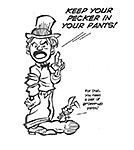
10.jpg)
11.jpg)
12.jpg)
13.jpg)
14.jpg)
15.jpg)
16.jpg)
17.jpg)
18.jpg)
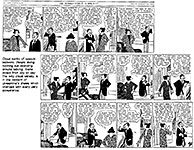
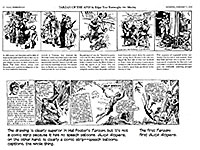
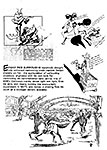
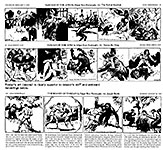
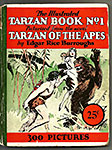
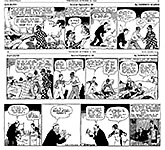


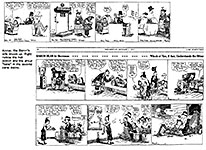
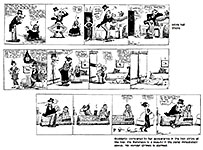
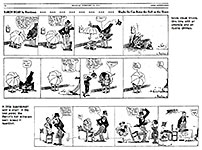
1.jpg)
2.jpg)
